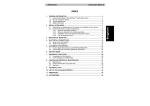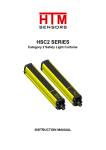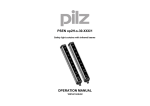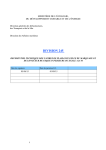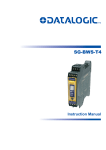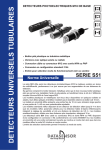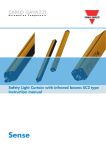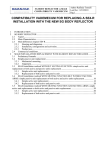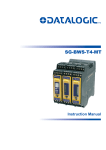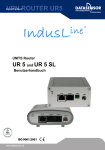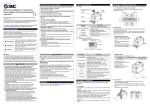Download "user manual"
Transcript
Safety light curtains with infrared beams INSTRUCTION MANUAL DATASENSOR S.p.A. Via Lavino 265 40050 Monte S. Pietro - Bologna - Italy Tel: +39 051 6765611 Fax: +39 051 6759324 http://www.datasensor.com e-mail: [email protected] DATASENSOR S.p.A. reserves the right to make modifications and improvements without prior notification. 826003781 Rev.C Copyright © 2008-2009 Datasensor We DATASENSOR S.p.A. Via Lavino, 265 40050 Monte San Pietro Bologna - Italy DECLARATION OF CONFORMITY Declare, under the terms of EC Machine Directive 98/37/EEC, Appendix II C, that the product(s) SG2-XX-XXX-OO-X SAFETY LIGHT CURTAINS ELECTRO-SENSITIVE PROTECTIVE EQUIPMENT (TYPE 2) AND ALL ITS MODELS are safety components for a machine constructed as per the EC Directive 98/37/EEC. This declaration will lose its validity if any modification to devices is applied without prior consultation. We employ a quality system certified by the CSQ, Nr. 9115.IES2, as per ISO 9001 and have therefore observed the regulations foreseen during development and production, as well as the following EC directives and EN standards: EC directives 98/37/EEC: EC MACHINE DIRECTIVE ED. 22 JUNE 1998 89/336/EEC: EMC DIRECTIVE ED. 3 MAY 1989 2006/95/EEC: LOW-VOLTAGE DIRECTIVE ED. 12 DECEMBER 2006 Harmonized standards EN 55022, 2006: LIMITS AND METHODS OF MEASUREMENTS OF RADIO DISTURBANCE OF INFORMATION TECHNOLOGY EQUIPMENT EN 61000-4-2, 1995 + A1:1998 + A2:2001: ELECTROMAGNETIC COMPATIBILITY (EMC). PART 4: TESTING AND MEASUREMENT TECHNIQUES. SECTION 2: ELECTROSTATIC DISCHARGE IMMUNITY TEST EN 61000-4-3, MAY 2006: ELECTROMAGNETIC COMPATIBILITY (EMC). PART 4: TESTING AND MEASUREMENT TECHNIQUES. SECTION 3: RADIATED, RADIO-FREQUENCY, ELECTROMAGNETIC FIELD IMMUNITY TEST EN 61000-4-4, DECEMBER 2004: ELECTROMAGNETIC COMPATIBILITY (EMC). PART 4: TESTING AND MEASUREMENT TECHNIQUES. SECTION 4: ELECTRICAL FAST TRANSIENT/BURST IMMUNITY TEST EN 61000-4-5, NOVEMBER 2006: ELECTROMAGNETIC COMPATIBILITY (EMC). PART 4: TESTING AND MEASUREMENT TECHNIQUES. SECTION 5: SURGE IMMUNITY TEST EN 61000-4-6, 1996 + A1:2001: ELECTROMAGNETIC COMPATIBILITY (EMC). PART 4: TESTING AND MEASUREMENT TECHNIQUES. SECTION 6: IMMUNITY TO CONDUCTED DISTURBANCES, INDUCED BY RADIO-FREQUENCY FIELDS EN 61508-3, DECEMBER 2001: FUNCTIONAL SAFETY OF ELECTRICAL/ELECTRONIC/PROGRAMMABLE ELECTRONIC SAFETY-RELATED SYSTEMS. PART 3: SOFTWARE REQUIREMENTS EN 61496-1, MAY 2004: SAFETY OF MACHINERY - ELECTRO-SENSITIVE PROTECTIVE EQUIPMENT. PART 1: GENERAL REQUIREMENTS AN TESTS CLC/TS 61496-2, JULY 2006: SAFETY OF MACHINERY - ELECTRO-SENSITIVE PROTECTIVE EQUIPMENT. PART 2: PARTICULAR REQUIREMENTS FOR EQUIPMENT USING ACTIVE OPTO-ELECTRONIC PROTECTIVE DEVICES (AOPDS) Conformity has been certified by the following Competent Body (identification n°0123): TÜV Product Service GMBH, Zertifierstelle – Ridlerstrasse, 65 – D80339 München Monte San Pietro, 08/05/2008 Giuseppe De Maria UNI EN ISO 14001 Quality Assurance SG2-B Series Instruction Manual INDEX 1. GENERAL INFORMATION .......................................................................................... 1 1.1. General description of the safety light curtains ................................................... 1 1.1.1. Package contents ................................................................................... 3 1.2. New features compared to the SF2 Series ......................................................... 3 1.3. How to choose the device ................................................................................... 4 1.3.1. Resolution............................................................................................... 4 1.3.2. Controlled height .................................................................................... 5 1.3.3. Minimum installation distance ................................................................ 6 1.4. Typical applications ............................................................................................. 9 1.5. Safety information ............................................................................................. 12 2. INSTALLATION MODE.............................................................................................. 13 2.1. Precautions to be observed for the choice and installation of the device ........ 13 2.2. General information on device positioning ........................................................ 14 2.2.1. Minimum installation distance .............................................................. 15 2.2.2. Minimum distance from reflecting surfaces .......................................... 16 2.2.3. Emitter and receiver orientation ........................................................... 18 2.2.4. Installation of several adjacent safety light curtains ............................. 19 2.2.5. Use of deviating mirrors........................................................................ 20 2.2.6. Controls after first installation ............................................................... 21 3. MECHANICAL MOUNTING ....................................................................................... 23 4. ELECTRICAL CONNECTIONS ................................................................................. 26 4.1. Notes on connections........................................................................................ 27 4.2. Earth connection ............................................................................................... 30 5. ALIGNMENT PROCEDURE ...................................................................................... 31 5.1. Correct alignment procedure............................................................................. 33 6. FUNCTIONING MODE ............................................................................................... 35 6.1. Reset mode ....................................................................................................... 35 6.2. Test function...................................................................................................... 35 6.3. Reset function ................................................................................................... 36 7. DIAGNOSTIC FUNCTIONS ....................................................................................... 37 7.1. User interface .................................................................................................... 37 7.2. Diagnostic messages ........................................................................................ 38 8. PERIODICAL CHECKS ............................................................................................. 40 8.1. General information and useful data ................................................................. 41 8.2. Warranty............................................................................................................ 42 9. DEVICE MAINTENANCE ........................................................................................... 43 9.1. Product disposal................................................................................................ 43 10. TECHNICAL DATA .................................................................................................... 44 11. LIST OF AVAILABLE MODELS ................................................................................ 45 12. OVERALL DIMENSIONS ........................................................................................... 46 13. OUTFIT ....................................................................................................................... 47 13.1 Angled fixing bracket mounting ......................................................................... 48 14. ACCESSORIES.......................................................................................................... 49 15. GLOSSARY................................................................................................................ 55 Instruction Manual SG2-B Series 1. GENERAL INFORMATION 1.1. General description of the safety light curtains The safety light curtains of the SG2 series are optoelectronic multibeam devices that are used to protect working areas that, in presence of machines, robots, and automatic systems in general, can become dangerous for operators that can get in touch, even accidentally, with moving parts. The light curtains of the SG2 series are Type 2 intrinsic safety systems used as accident-prevention protection devices and are manufactured in accordance with the international Standards in force for safety, in particular: CEI IEC 61496-1: 2004 Safety of machinery: electrosensitive protective equipment. Part 1: General prescriptions and tests. CEI IEC 61496-2: 2006 Safety of machinery: electrosensitive protective equipment Particular requirements for equipment using active optoelectronic protective devices. The device, consisting of one emitter and one receiver housed inside strong aluminium profiles, generates infrared beams that detect any opaque object positioned within the light curtain detection field. The emitter and the receiver are equipped with the command and control functions. The connections are made through a M12 connector located in the lower side of the profile. The synchronisation between the emitter and the receiver takes place optically, i.e. no electrical connection between the two units is required. The microprocessor guarantees the check and the management of the beams that are sent and received through the units. The microprocessor – through some LEDs – informs the operator about the general conditions of the safety light curtain (see section 7 “Diagnostic functions”). 1 SG2-B Series Instruction Manual The device consists in 2 units that, according to the model, are composed by one or several emitting and receiving modules. The receiver checks the control operations and safety actions. During installation, two yellow LEDs facilitate the alignment of both units (see section 5 “Alignment procedure”). As soon as an object, a limb or the operator’s body accidentally interrupts one or some of the infrared beams sent by the emitter, the receiver immediately opens the OSSD outputs and blocks the MPCE machine (if correctly connected to the OSSD). Some parts or sections of this manual containing important information for the operator are preceded by a note: Notes and detailed descriptions about particular characteristics of the safety devices in order to better explain their functioning. Special instructions regarding the installation process. The information provided in the paragraphs following this symbol is very important for safety and may prevent accidents. Always read this information accurately and carefully follow the advice to the letter. This manual contains all the information necessary for the selection and operation of the safety devices. However, specialised knowledge not included in this technical description is required for the planning and implementation of a safety light curtain on a power-driven machine. As the required knowledge may not be completely included in this manual, we suggest the customer to contact DATASENSOR Technical Service for any necessary information relative to the functioning of the SG2 light curtains and the safety rules that regulate the correct installation (see section 8 “Periodical checks ”). 2 Instruction Manual SG2-B Series 1.1.1. Package contents Package contains the following objects: • Receiver (RX) • Emitter (TX) • Quick Guide for first installation • CD with user manual and other documents • Checklist and periodical maintenance schedule • 4 angled fixing brackets and specific fasteners • 2 angled fixing brackets for models with heights included between 1200 and 1800 mm 1.2. New features compared to the SF2 Series The SG2-B safety light curtains, compared to the SF2 series, present the following new features: • Increased operating distance • Range enlargement with 150 to 1800 mm controlled heights • Reduced response times • New fastening system with rotating brackets • New mechanical profile compatible with SE accessories • Different positioning of synchronisation optics (the first one from the reference line) • Different mechanical mounting 3 SG2-B Series Instruction Manual 1.3. How to choose the device There are at least three different main characteristics that should be considered when choosing a safety light curtain, after having evaluated the risk assessment: 1.3.1. Resolution The resolution of the device is the minimum dimension that an opaque object must have in order to obscure at least one of the beams that constitute the sensitive area. The resolution strictly depends on the part of the body to be protected. R = 30 mm hand protection Type 2 R = 50 mm R = 90 mm presence control As shown in Fig.1, the resolution only depends on the geometrical characteristics of the lenses, diameter and distance between centres, and is independent from any environmental and operating conditions of the safety light curtain. Fig. 1 The resolution value is obtained applying the following formula: R=I+d where: I d = Distance between two adjacent optics = Lens diameter 4 Instruction Manual SG2-B Series 1.3.2. Controlled height The controlled height is the height protected by the safety light curtain ( Hp ) Fig. 2 The SG2-B controlled height is delimited by the yellow line padprinted on the front glass and by the dimensions listed in the table: Model Hp Reference SG2-30-015-OO-X 150 SG2-kk-030-OO-X 300 SG2-kk-045-OO-X 450 SG2-kk-060-OO-X 600 SG2-kk-075-OO-X 750 SG2-kk-090-OO-X 900 SG2-kk-105-OO-X 1050 SG2-kk-120-OO-X 1200 SG2-kk-135-OO-X 1350 SG2-kk-150-OO-X 1500 SG2-k-165-OO-X 1650 SG2-kk-180-OO-X 1800 kk = Resolution (30mm – 50 mm – 90 mm) 5 Controlled height Hp (mm) SG2-B Series Instruction Manual 1.3.3. Minimum installation distance The safety device must be positioned at a specific safety distance (Fig. 3). This distance must ensure that the dangerous area cannot be reached before the dangerous motion of the machine has been stopped by the ESPE. The safety distance depends on 4 factors, according to the EN-999 Standard: • Response time of the ESPE (the time between the effective beam interruption and the opening of the OSSD contacts). • Machine stopping time (the time between the effective opening of the contacts of the ESPE and the real stop of the dangerous motion of the machine). • ESPE resolution. • Approaching speed of the object to be detected. Fig. 3 The following formula is used for the calculation of the safety distance: S = K (t1 + t2) + C where: S = Minimum safety distance in mm. K = Speed of the object, limb or body approaching the dangerous area in mm/sec. t1 = Response time of the ESPE in seconds (see section 9 “Technical data”) t2 = Machine stopping time in seconds. d = Resolution of the system. C = Additional distance based on the possibility to insert the body or one of body parts inside the dangerous area before the protective device trips. C = 8 (d -14) for devices with resolution ≤ 40mm C = 850 mm for devices with resolution > 40mm. 6 Instruction Manual SG2-B Series NOTE: K value is: 2000 mm/s if the calculated value of S is ≤ 500 mm 1600 mm/s if the calculated value of S is > 500 mm When devices with >40 mm resolution are used, the height of the top beam has to be ≥ 900 mm (H2) from machine supporting base while the height of the bottom beam has to be ≤ 300 mm (H1). If the safety light curtain must be mounted in a horizontal position (Fig.4), the distance between the dangerous area and the most distant optical beam must be equal to the value calculated using the following formula: S = 1600 mm/s (t1 + t2) + 1200 – 0.4 H where: S = Minimum safety distance in mm. t1 = Response time of the ESPE in seconds (see section 9 “Technical data”) t2 = Machine stopping time in seconds. H = Beam height from ground; this height must always be less than 1,000 mm. Fig. 4 7 SG2-B Series Instruction Manual Practical examples: Let's suppose to have a light curtain with height = 600 mm 1) To calculate the distance of the device from the ESPE, in a vertical position, the following formula is used: S = K*T + C where: T = t1 + t2 t1 = ESPE response time + SE-SR2 relay release time (max 80 ms) t2 = Machine total stopping time. C = 8 * (d – 14) for devices with resolution <= 40 mm C = 850 for devices with resolution > 40 mm d = Resolution of the system. In all cases, if K = 2000mm/sec then S will be > 500 mm. Distance will have then to be recalculated using K = 1600 mm/sec. T C S SG2-30-060 0.398 sec 128 mm 764.8 mm SG2-50-060 0.393 sec 850 mm 1478.8 mm SG2-90-060 0.391 sec 850 mm 1475.6 mm 2) To calculate the distance of the device from the ESPE, in a horizontal position, the following formula is used: S = 1600 * T + 1200 – 0.4 * H where: H = Beam min. height from ground 15 * (d – 50) D = resolution T H S - SG2-50-060 0.3 sec 0 mm 1828.8 mm SG2-90-060 0.391 sec 600 mm 1585.6 mm WARNING: the reference standard is EN-999 “Machine safety - the positioning of the protective device based on the approaching speed of the human body”. This information is just an indication and a kind of summary. For safety distance correct calculation, it is compulsory to refer to the whole EN999 standard. 8 Instruction Manual SG2-B Series 1.4. Typical applications The safety light curtains of the SG2 series are used in all automation fields where the control and protection of the access to dangerous areas are necessary. In particular, they are used to stop the moving of mechanical parts in: - Automatic machines; - Machines for packaging, material handling, storing; - Weaving machines, wood working machines, ceramic working machines; - Automatic and semiautomatic assembly lines; - Automatic warehouses. In food industry applications, DATASENSOR Technical Service has to verify the compatibility of the material of the safety light curtain housing with any chemical agents used in the production process. Example 1: Hand protection on moulding machines In order to protect the light curtain against dust and humidity, the IP69K protective enclosure is used. The aim is to prevent operator's hands from being squashed during the final product stacking process. In addition, the solution must not interfere with the manufacturing process. Working premises are characterised by a humidity of 85% and a temperature of 25 °C. Moreover, washing with cold high-pressure waterjets is frequent, as well as the use of alkaline detergents or acids. 9 SG2-B Series Instruction Manual Solution: the IP69K protective enclosure, made from an acrylic PMMA tube, is an effective protection without traps for dirt or contamination. The cap’s O’ring prevents water or dirt from entering the tube and at the same time, prevents also internal condensation. The cable connecting the enclosure to the light curtain is protected and fixed thanks to a PG gland that prevents water or dirt from entering the tube. Advantages: The use of SG2 with the IP69K enclosure ensures reliable protection under extreme environmental conditions. Not only does the IP69K protective enclosure meet hygiene, washing resistance, availability and safety requirements, but also ergonomic and productivity requirements, as the protected area remains always accessible when the machine is stopped. Example 2: Cooling and conditioning systems Cooling and conditioning systems, as well as automotive equipment and components are checked inside a machine, to detect possible leaks by a helium mass spectrometer. The point where these parts are positioned inside the measuring chamber requires a Type 2 protection ensuring a certain space saving and an easy access to the protected area. Solution: the SG2 safety light curtain series represents the ideal solution if the safety requirements and the application are considered. When even just one of the light curtain beams is interrupted, the test machine is immediately stopped. Advantages: the SG2 light curtain meets the customer's needs when easy access is necessary in presence of machine stops. Easy installation, configuration and use are other advantages. 10 Instruction Manual SG2-B Series Example 3: Automatic warehouses Operator protection in automatic warehouses. Solution: the SG2 safety light curtain series represents the ideal solution if the safety requirements and the application are considered. When even just one of the light curtain beams is interrupted, the carousel is immediately stopped. Advantages: the SG2 light curtain meets the customer's needs when easy access is necessary in presence of machine stops. Easy installation, configuration and use are other advantages. 11 SG2-B Series Instruction Manual 1.5. Safety information For a correct and safe use of the safety light curtains of the SG2 series, the following points must be observed: • The stopping system of the machine must be electrically controlled. • This control system must be able to stop the dangerous movement of the machine within the total machine stopping time T as per par. 1.1.3, and during all working cycle phases. • Mounting and connection of the safety light curtain must be carried out only by qualified personnel, according to the indications included in the special sections (refer to sections 2; 3; 4; 5) and in the applicable Standards. • The safety light curtain must be securely installed in a particular position so that access to the dangerous zone is not possible without the interruption of the beams (see section 2 “Installation mode”). • The personnel operating in the dangerous area must be well trained and must have adequate knowledge of all the operating procedures of the safety light curtain. • The TEST button must be located outside the protected area because the operator must check the protected area during all Test and Reset operations. Please carefully read the instructions for the correct functioning before powering the light curtain. 12 Instruction Manual SG2-B Series 2. INSTALLATION MODE 2.1. Precautions to be observed for the choice and installation of the device Make sure that the protection level assured by the SG2 device (Type 2) is compatible with the real danger level of the machine to be controlled, according to EN 954-1 and EN13849. • The outputs (OSSD) of the ESPE must be used as machine stopping devices and not as command devices. The machine must have its own START command. • The dimension of the smallest object to be detected must be larger than the resolution level of the device. • The ESPE must be installed in a room complying with the technical characteristics indicated in section 10 “Technical data”. • Do not place the device near intense and/or flashing light sources and, in particular, close to receiving unit front surface. • The presence of intense electromagnetic disturbances could affect device correct operation. This condition shall be carefully assessed by seeking the advice of DATASENSOR Technical service. • The operating distance of the device can be reduced in presence of smog, fog or airborne dust. • A sudden change in environment temperature, with very low minimum peaks, can generate a small condensation layer on the lenses and so jeopardise functioning. 13 SG2-B Series Instruction Manual 2.2. General information on device positioning The safety light curtain should be carefully positioned, in order to reach a very high protection standard. Access to the dangerous area must only be possible by passing through the protecting safety light beams. Fig.5a shows some examples of possible access to the machine from the top and the bottom sides. These situations may be very dangerous and so the installation of the safety light curtain at sufficient height in order to completely cover the access to the dangerous area (Fig.5b) becomes necessary. NO Fig.5a YES Fig.5b Under standard operating conditions, machine starting must not be possible while operators are inside the dangerous area. 14 Instruction Manual SG2-B Series When the installation of the safety light curtain very near to the dangerous area is not possible, a second light curtain must be mounted in a horizontal position in order to prevent any lateral access (as shown in Fig.6b). If the operator is able to enter the dangerous area, an additional mechanical protection must be mounted to prevent the access. NO Fig.6a YES Fig.6b 2.2.1. Minimum installation distance Refer to par.1.3.3. “Minimum installation distance” 15 SG2-B Series Instruction Manual 2.2.2. Minimum distance from reflecting surfaces Reflecting surfaces placed near the light beams of the safety device (over, under or laterally) can cause passive reflections. These reflections can compromise the recognition of an object inside the controlled area. However, if the RX receiver detects a secondary beam (reflected by the side-reflecting surface) the object might not be detected, even if the object interrupts the main beam. Fig. 7 16 Instruction Manual SG2-B Series It is thus important to position the safety light curtain according to the minimum distance from reflecting surfaces. The minimum distance depends on: • Operating distance between emitter (TX) and receiver (RX); • Real opening angle of ESPE (EAA); in particular: for ESPE type 2 EAA = 10° (α = 5°) Distance from reflecting surface (Dsr) Diagram of Fig. 8 shows the min. distance from the reflecting surface (Dsr), based on the operating distance: ESPE Type 2 Operating distance Fig. 8 The formula to get Dsr is the following: Dsr (m) = 0.27 Dsr (m) = 0,5 operating distance (m) x tg 2α 17 for oper. distances < 3 m for oper. distances ≥ 3 m SG2-B Series Instruction Manual 2.2.3. Emitter and receiver orientation The two units shall be installed parallel to each other, with the beams orthogonal respect to the emitting and receiving directions, with the connectors positioned in the same manner. The configurations shown in Fig. 9 must be avoided: NO NO Fig.9 18 Instruction Manual SG2-B Series 2.2.4. Installation of several adjacent safety light curtains When several safety devices must be installed in adjacent areas, interferences between the emitter of one device and the receiver of the other must be avoided. Fig.10 provides an example of possible interferences between different devices and two pertinent solutions. NO YES RX TX YES Fig.10 19 SG2-B Series Instruction Manual 2.2.5. Use of deviating mirrors The control of any dangerous area, with several but adjacent access sides, is possible using only one safety device and well-positioned deviating mirrors. Fig.11 shows a possible solution to control three different access sides, using two mirrors placed at 45° with respect to the beams. Fig. 11 The operator must respect the following precautions when using the deviating mirrors: • The alignment of the emitter and the receiver can be a very critical operation when deviating mirrors are used. Even a very small mirror displacement is enough to lose alignment. The use of the Datasensor laser pointer accessory is recommended under these conditions. • The minimum safety distance (S) must be respected for each single section of the beams. • The effective operating range decreases by about 15% by using only one deviating mirror, the percentage further decreases by using 2 or more mirrors (for more details refer to the technical specifications of the mirrors used). The following table shows the operating distances relating to the number of mirrors used. number of mirrors 1 2 3 operating distance 16.5 m 13.7 m 11.6 m • Do not use more than three mirrors for each device. • The presence of dust or dirt on the reflecting surface of the mirror causes a drastic reduction in the range. 20 Instruction Manual SG2-B Series 2.2.6. Controls after first installation The control operations to carry-out after the first installation and before machine start-up are listed hereinafter. The controls must be carried-out by qualified personnel, either directly or under the strict supervision of the person in charge of machinery Safety. Verify that: ) intercepting the beams along the ESPE remains blocked ( protected area using the specific test piece, following the Fig.12 scheme. TP30 for light curtains with 30 mm resolution: SG2-30-XX-X TP50 for light curtains with 30 mm resolution: SG2-50-XX-X TP90 for light curtains with 30 mm resolution: SG2-90-XX-X Fig. 12 • ESPE has to be correctly aligned, press slightly on the product side in both directions the red LED must not turn on . • The activation of the TEST function causes the opening of the on and controlled machine stop). OSSD outputs (red LED • The response time at machine STOP, including the ESPE and machine response times, must be included in the limits defined in the calculation of the safety distance (refer to section 2 “Installation modes”). • The safety distance between the dangerous parts and ESPE must comply with the requirements indicated in section 2 “Installation modes”. 21 SG2-B Series Instruction Manual • A person must not access or remain between ESPE and the dangerous parts of the machine. • Access to the dangerous areas of the machine must not be possible from any unprotected area. • ESPE must not be disturbed by external light sources, ensuring that it remains in Normal operating function for at least 10-15 minutes and placing the specific test piece in the protected area in the SAFE condition for the same period. • Verify the correspondence of all the accessory functions, activating them in the different operating conditions. 22 Instruction Manual SG2-B Series 3. MECHANICAL MOUNTING The emitting (TX) and receiving (RX) units must be installed with the relevant sensitive surfaces facing each other. The connectors must be positioned on the same side and the distance must be included within the operating range of the model used (see section 10 “Technical data”). The two units must be positioned the most aligned and parallel possible. The next step is the fine alignment, as shown in section 5 “Alignment Procedure”. Two types of brackets can be used to fix the two units: Angled fixing brackets Angled fixing brackets are supplied with all SG2-B models (Fig.13). Adjustable supports for correcting unit inclination on the axes are available on request (see section.14 “Accessories”). For fixing with angled brackets, refer to Fig.13. Fig. 13 23 SG2-B Series Instruction Manual Rotating brackets Rotating brackets (Fig.14), available upon request, can be used as an alternative or together with angled brackets. For fixing with rotating bracket, refer to Fig.14. Fig. 14 In case of applications with particularly strong vibrations, vibration dampers, together with mounting brackets, are recommended to reduce the impact of the vibrations. Fig. 15 The recommended mounting positions according to the light curtain length are shown in Fig.15 and in the following table. 24 Instruction Manual MODELS SG2-B Series L (mm) A (mm) B (mm) SG2-30-015-OO-X 216.3 108 54 - SG2-kk-030-OO-X 366.2 216 75 - SG2-kk-045-OO-X 516.3 316 100 - SG2-kk-060-OO-X 666.2 366 150 - SG2-kk-075-OO-X 816.3 466 175 - SG2-kk-090-OO-X 966.2 566 200 - SG2-kk-105-OO-X 1116.2 666 225 - SG2-kk-120-OO-X 1266.3 966 150 483 SG2-kk-135-OO-X 1416.2 1066 175 533 SG2-kk-150-OO-X 1566.3 1166 200 583 SG2-kk-165-OO-X 1716.3 1266 225 633 SG2-kk-180-OO-X 1866.3 1366 250 683 kk = Resolution (30mm – 50 mm – 90 mm) 25 C (mm) SG2-B Series Instruction Manual 4. ELECTRICAL CONNECTIONS All electrical connections to the emitting and receiving units are made through a male M12 connector, located on the lower part of the two units. For receiver a M12 5-pole connector is used, while for emitter a M12 4-pole connector is used. RECEIVER (RX): OSSD1 2 +24 VDC 1 5 TEST/RESET 4 3 OSSD2 0V 1 2 3 4 5 = = = = = brown white blue black grey = = = = = +24 VDC OSSD 1 0V OSSD 2 TEST/RESET EMITTER (TX): NOT USED 0V 1 2 3 4 = = = = brown white blue black = = = = +24 VDC 2 1 3 4 NOT USED +24 VDC NOT USED 0V NOT USED 26 Instruction Manual SG2-B Series 4.1. Notes on connections For the correct functioning of the SG2 safety light curtains, the following precautions regarding the electrical connections have to be respected: • Do not place connection cables in contact with or near high-voltage cables and/or cable undergoing high current variations (e.g. motor power supplies, inverters, etc.); • Do not connect in the same multi-pole cable the OSSD wires of different light curtains; • The TEST/RESET wire must be connected through a N.O. button to the supply voltage of the ESPE. The TEST/RESET button must be located in such a way that the operator can check the protected area during any Test and Reset operation. (see section 6 “Functioning mode”). • The device is protected internally against overvoltage and overcurrent. The use of other external components is not recommended. 27 SG2-B Series Instruction Manual Example: connection with safety relay The figures show the connection between the safety light curtains and the safety relay of the SE-SR2 series functioning in the Automatic Start mode (left side) and Manual Start with monitoring (right side). • Do not use varistors, RC circuits or LEDs in parallel at relay inputs or in series at OSSD outputs. • The OSSD1 and OSSD2 safety contacts cannot be connected in series or in parallel, but can be used separately (Fig.16). If one of these configurations is erroneously used, the device enters into the output failure condition (see section 7 “Diagnostic functions”). 28 Instruction Manual SG2-B Series • Connect both OSSDs to the activating device. Failure to connect an OSSD to the activating device jeopardises the system safety degree that the light curtain has to control YES NO Fig. 16 NO Fig. 18 29 Fig. 17 NO Fig. 19 SG2-B Series Instruction Manual 4.2. Earth connection SG2 safety light curtain units are preset for easy ground connection. A special compartment, positioned onto caps and marked with the special symbol shown in Figure 20, allows connection with ground cable by means of an additional screw coming with the equipment. Fig. 20 Ground connection configuration is the most common and guarantees the best immunity against electromagnetic disturbances. SG2-E can function even without ground connection. This condition has to be carefully evaluated according to the EMC disturbance immunity and necessary insulation class considering the plant or entire system where the light curtain is installed. • The ground connection of the two units is not necessary for Class III, while the use of a duly-insulated low-voltage feeder type SELV or PELV is compulsory. In this case, we recommend covering the earth symbol present on the caps of the two units with a blank sticker. • The ground connection of the two units is compulsory for Class I, while the use of a duly-insulated feeder type SELV or PELV is not compulsory but anyway recommended. The following table is a summary of SG2-B electrical protections. Electrical protections Ground Connection Ground connection symbol Power supply by generators SELV / PELV Class I Compulsory Compulsory Class III Not necessary Not necessary Recommended Compulsory 30 Instruction Manual SG2-B Series 5. ALIGNMENT PROCEDURE The alignment between the emitting and the receiving units is necessary to obtain the correct functioning of the light curtain. A good alignment prevents outputs instability caused by dust or vibrations. The alignment is perfect if the optical axes of the first and the last emitting unit’s beams coincide with the optical axes of the corresponding elements of the receiving unit. The beam used to synchronise the two units is the first after the connector. SYNC is the optics connected with this beam and LAST is the optics connected to the last beam after the SYNC unit. last optics (LAST) first optics = synchronisation optics (SYNC) Fig.21 Signals are clearly identified through symbols allowing immediate reading, independent of bars directions. A short description of the signalling LEDs is necessary to avoid misunderstandings. Receiver Emitter NORMAL OP. LAST SAFE(BREAK) SYNC NORMAL OP. ON Fig. 22 31 SG2-B Series Instruction Manual The standard installation described hereinafter is the one shown in Fig. 22, i.e. with the bar assembled with the connectors pointing down. Two yellow LEDs ( LAST, SYNC) on SG2 receiver, facilitates the alignment procedure. During standard operation, the LEDs indicate the safety light curtain status, as shown in the table. FUNCTIONING STATUS LED colour Symbol Normal Status NORMAL OP. Stop Status SAFE(BREAK) Yellow OFF ON OFF OFF Yellow OFF ON ON OFF Red OFF ON ON ON Green ON OFF OFF - Standard condition: - Not interrupted beams - Units not - Bottom side aligned not aligned - Top side not Lowest beam aligned interrupted - Highest beam interrupted OFF Units aligned, but at least one of beams (the highest and lowest excluded) is interrupted 32 Instruction Manual SG2-B Series 5.1. Correct alignment procedure The light curtain alignment can be effected only after having completed the mechanical installation and the electrical connections. The following procedure has to be followed: • Check the green LED () and the yellow LED ( unit. If ON, the emitter is running correctly; ) on the TX • Verify that the sensitive area from the safety light curtain is free; • Verify that one of the following conditions is present on the RX unit: STANDARD CONDITION - NORMAL OP. ) ON and red LED ( • Green LED ( LEDs ( , ) are OFF. Units are aligned. ) OFF. Both yellow STOP CONDITION - SAFE (BREAK) • Green LED ( ) OFF and red LED ( • The status of both yellow LEDs ( not aligned. , ) ON. ) does not matter. Units are • Continue with the following steps to pass from condition 2 to condition 1: A Keep the receiver in a steady position and set the emitter until SYNC) is OFF. This condition shows the the yellow LED ( effective alignment of the first synchronisation beam. B Rotate the emitter, pivoting on the lower optics axis, until the yellow LED ( LAST) is OFF. Under these conditions, the SAFE LED shall turn ON. NOTE: Ensure that the green LED is steady ON. C Delimit the area in which the LED is steady through some micro adjustments - for the first and then for the second unit then place both units in the centre of this area. 33 SG2-B Series Instruction Manual • Fix the two units firmly using brackets. • Verify that the green LED on the RX unit is ON ( ) and beams are not interrupted, then verify that the red LED turns ON if even one single beam is interrupted (condition where an object has been detected). • This verification shall be made with the special cylindrical “Test Piece” having a size suitable to the resolution of the device used. NOTE: Passing the Test Piece along the whole sensitive area and at any distance from the two units, the red LED ( ) shall be always ON and never change status. A daily test is recommended. 34 Instruction Manual SG2-B Series 6. FUNCTIONING MODE 6.1. Reset mode The interruption of a beam due to an opaque object causes the opening of OSSD outputs and the stop of the safety light curtain SAFE (BREAK) condition . The ESPE will automatically restart its standard operation (NORMAL OP. condition ) as soon as the object is removed. WARNING: Carefully assess risk conditions and reset modes. In applications protecting access to dangerous areas, the automatic reset mode is potentially unsafe if it allows the operator to pass completely beyond the sensitive area (see Fig. 6b). In this case, the reset, using for example the manual reset of the SE-SR2 relay, (page 26) might be necessary. 6.2. Test function The TEST function can be activated by keeping a normally open external contact (TEST push-button), closed for at least 0.5 seconds. The TEST signal is active high. 35 SG2-B Series Instruction Manual 6.3. Reset function The RX light curtain has a RESET function which is activated after an internal error. The reset can be made only in case of optical error or OSSD error (See sect. 7 “Diagnostic Functions”) The RESET function can be activated by keeping a normally open external contact (RESET/RESTART push-button), closed for at least 5 seconds. The RESET signal is active high. 36 Instruction Manual SG2-B Series 7. DIAGNOSTIC FUNCTIONS 7.1. User interface The operator can visualise the operating condition of the light curtains through the four LEDs positioned on the receiver unit and two LEDs on the emitter unit. Fig.23 shows all signalling LEDs modes: OFF, ON and BLINKING. LED OFF LED BLINKING LED ON Fig. 23 37 SG2-B Series Instruction Manual 7.2. Diagnostic messages The operator is able to check the main causes of the system stop and failure, using the same LEDs used for visualising the functions. For Receiver: Function Normal operation Function Status Meaning TEST (red ON) Light curtain being tested, the OSSD status shall be OFF Emission (OSSD ON) (green ON) Interruption (OSSD OFF) (red ON) Type OSSD error (yellow and red BLINKING) Error status Internal error (red ON, yellow BLINKING) LED Light curtain working and in standard operating conditions Light curtain working and in safety block conditions. Check and repair LED Check OSSD connections; make sure that they are not in contact with one another or with the supply cables, then Reset. If the failure continues contact DATASENSOR Switch OFF and switch ON the supply circuit; if the failure continues contact DATASENSOR Optical error (red ON, yellow BLINKING) Reset. If the failure continues contact DATASENSOR No power supply (LEDs OFF) Check connections and input voltage correct value. If the failure continues contact DATASENSOR 38 Instruction Manual SG2-B Series For Emitter: Function Status Meaning Test (green ON) Light curtain being tested, the OSSD status must be OFF Emission (green ON yellow ON) Light curtain working in normal operating conditions Type Check and repair Internal error (green ON yellow BLINKING) Optic error (green ON yellow BLINKING) Switch OFF and switch ON the power supply circuit. If the failure continues contact DATASENSOR LED Normal operation Function Error status No power supply (LEDs OFF) 39 Switch OFF and switch ON the power supply circuit. If the failure continues contact DATASENSOR Check connections and input voltage value. If the failure continues contact DATASENSOR LED SG2-B Series Instruction Manual 8. PERIODICAL CHECKS The following is a list of recommended check and maintenance operations that should be periodically carried out by qualified personnel. Check that: • The ESPE stays locked ( ) during beam interruption along the entire protected area, using the suitable “Test Piece”. (*) • The ESPE is correctly aligned: by slightly pressing product side, in . both directions, the red LED shall not come ON • Enabling the TEST function, the OSSD outputs should open (the is ON and the controlled machine stops). red LED • The response time upon machine STOP (including response time of the ESPE and of the machine) is within the limits defined for the calculation of the safety distance (see section 2 “Installation mode”). • The safety distance between the dangerous areas and the ESPE are in accordance with the instructions included in section 2 “Installation mode”. • Access of a person between ESPE and machine dangerous parts is not possible nor is it possible for him/her to stay there. • Access to the dangerous area of the machine from any unprotected area is not possible. • The ESPE and the external electrical connections are not damaged. The frequency of checks depends on the particular application and on the operating conditions of the safety light curtain. (*) according to the Fig.12 scheme Verify that: ) intercepting the beams along the ESPE remains blocked ( protected area using the specific test piece, following the Fig.12 scheme. TP30 for light curtains with 30 mm resolution: SG2-30-XX-X TP50 for light curtains with 50 mm resolution: SG2-50-XX-X TP90 for light curtains with 90 mm resolution: SG2-90-XX-X 40 Instruction Manual SG2-B Series 8.1. General information and useful data Safety MUST be a part of our conscience. The safety devices fulfil their safety function only if they are correctly installed, in accordance with the Standards in force. If you are not certain to have the expertise necessary to install the device in the correct way, DATASENSOR Customer Service is at your disposal to carry out the installation. The device uses fuses that are not self-resetting. Consequently, in presence of short-circuits causing the cut-off of these fuses, both units shall be sent to DATASENSOR service department. A power failure caused by interferences may cause the temporary opening of the outputs, but the safe functioning of the light curtain will not be compromised. 41 SG2-B Series Instruction Manual 8.2. Warranty DATASENSOR S.p.A. guarantees each brand new SG2 system, under standard use conditions, against manufacturing defects in material and workmanship for a period of 36 (thirty-six) months from the date of manufacturing. DATASENSOR S.p.A. will not be liable for any damages to persons and things caused by failure to stick to the correct installation modes and device use. Warranty validity is subject to the following conditions: • User shall notify DATASENSOR S.p.A. the failure within thirty-six months from product manufacturing date. • Failure or malfunction shall not have been originated directly or indirectly by: − use for unsuitable purposes; − failure to comply with the intended use prescriptions; − negligence, unskillfulness, wrong maintenance; − repairing, changes, adaptations not made by DATASENSOR S.p.A personnel, tampering with the device, etc.; − accidents or crashes (even due to transportation or by force majeure causes); − other causes not depending from DATASENSOR S.p.A. If the device does not work, send both units (receiver and emitter) to DATASENSOR S.p.A. The Customer is responsible for all transport charges and damage risks or material loss during transport, unless otherwise agreed. All replaced products and parts become a property of DATASENSOR S.p.A. DATASENSOR S.p.A. does not accept any warranty or right other than the above-described ones. No requests for compensation for expenses, activities stop or other factors or circumstances somehow connected to the failure of the product or one of its parts to operate cannot be put forward for any reason. In case of problems, please contact DATASENSOR S.p.A. Service Department: Tel.: +39 051 6765611 Fax.: +39 051 6759324 email: [email protected] 42 Instruction Manual SG2-B Series 9. DEVICE MAINTENANCE SG2 safety light curtains do not require special maintenance operations. To avoid the reduction of the operative distance, optics protective front surfaces shall be cleaned at regular intervals. To this end, use soft cotton cloths damped in water; do not apply too much pressure onto the surface so as not to make it dull. Please do not use on plastic surfaces or light curtain painted surfaces: • alcohol or solvents • wool or synthetic cloths • paper or other abrasive materials 9.1. Product disposal Under current Italian and European laws, DATASENSOR S.p.A. is not obliged to take care of product disposal at the end of its life. DATASENSOR S.p.A. recommends to dispose of the product in compliance with local laws or contact authorised waste collection centres. 43 SG2-B Series Instruction Manual 10. TECHNICAL DATA The product technical specifications are given below. ELECTRICAL DATA Power supply (Vdd): Unit current draw (TX): Unit current draw (RX): Outputs: Short-circuit protection: Output current: Output voltage – status ON: Output voltage – status OFF: Capacitive load Response times: Protected height: Safety category: Auxiliary functions: Electrical protection: Connections: Cables length (for power supply): OPTICAL DATA 24 Vdc ± 20% 2 W max 3.5 W max (without load) 2 PNP 1.4 A max 0.5 A max / each output Vdd –1 V min 0.2 V max 2.2 uF @ 24Vdc max See table below 150..1800mm Type 2 Reset / Test Class I / Class III (see sect.4.2) M12-4 poles for emitter M12-5 poles for receiver 50 m. max Infrared, LED (950 nm) Emitting light ( λ ) : Resolution: 30 - 50 - 90 mm Operating distance: 0.2…19 m Ambient light rejection: IEC-61496-2 MECHANICAL AND ENVIRONMENTAL DATA Operating temperature: -10…+ 55 °C Storage temperature: -25…+ 70 °C Humidity: 15…95 % (no condensation) Mechanical protection: IP 65 (EN 60529) Vibrations: Width 0.35 mm, Frequency 10 … 55 Hz 20 sweep per axis, 1octave/min (EN 60068-2-6) Shock resistance: 16 ms (10 G) 1,000 shocks per axis (EN 60068-2-29) Housing material: Painted aluminium (yellow RAL 1003) Front side material: PMMA Caps material: PC MAKROLON Weight (single unit): 1.3 kg / linear metre 44 Instruction Manual SG2-B Series 11. LIST OF AVAILABLE MODELS Model SG2-30-015-OO-X SG2-30-030-OO-X SG2-30-045-OO-X SG2-30-060-OO-X SG2-30-075-OO-X SG2-30-090-OO-X SG2-30-105-OO-X SG2-30-120-OO-X SG2-30-135-OO-X SG2-30-150-OO-X SG2-30-165-OO-X SG2-30-180-OO-X SG2-50-030-OO-X SG2-50-045-OO-X SG2-50-060-OO-X SG2-50-075-OO-X SG2-50-090-OO-X SG2-50-105-OO-X SG2-50-120-OO-X SG2-50-135-OO-X SG2-50-150-OO-X SG2-50-165-OO-X SG2-50-180-OO-X SG2-90-030-OO-X SG2-90-045-OO-X SG2-90-060-OO-X SG2-90-075-OO-X SG2-90-090-OO-X SG2-90-105-OO-X SG2-90-120-OO-X SG2-90-135-OO-X SG2-90-150-OO-X SG2-90-165-OO-X SG2-90-180-OO-X 45 Protected Height (mm) 150 300 450 600 750 900 1050 1200 1350 1500 1650 1800 300 450 600 750 900 1050 1200 1350 1500 1650 1800 300 450 600 750 900 1050 1200 1350 1500 1650 1800 No. Beams 8 16 24 32 40 48 56 64 72 80 88 96 9 13 17 21 25 29 33 37 41 45 49 5 7 9 11 13 15 17 19 21 23 25 Response time (msec) 8 9 11 12 14 15 17 18 20 21 23 24 9 10 11 12 14 15 16 17 18 19 20 9 10 11 12 13 14 15 16 17 18 19 Resolution (mm) 30 30 30 30 30 30 30 30 30 30 30 30 50 50 50 50 50 50 50 50 50 50 50 90 90 90 90 90 90 90 90 90 90 90 SG2-B Series Instruction Manual 36.9 Ø16 Ø16 M2 n°3 x2 32.3 M12 12.5 12. OVERALL DIMENSIONS 14 38 50.5 L2 L1 MODEL SG2-30-015-OO-X SG2-kk-030-OO-X SG2-kk-045-OO-X SG2-kk-060-OO-X SG2-kk-075-OO-X SG2-kk-090-OO-X SG2-kk-105-OO-X SG2-kk-120-OO-X SG2-kk-135-OO-X SG2-kk-150-OO-X SG2-kk-165-OO-X SG2-kk-180-OO-X kk = L1 233.3 383.2 533.2 683.2 833.2 983.2 1133.2 1283.3 1433.2 1583.3 1733.3 1883.3 L2 153.3 303.2 453.3 603.2 753.3 903.2 1053.2 1203.3 1353.2 1503.3 1653.3 1803.3 Resolution (30mm – 50 mm – 90 mm) 46 Instruction Manual 13. OUTFIT Angled fixing bracket 47 SG2-B Series SG2-B Series Instruction Manual 13.1 Angled fixing bracket mounting MOUNTING A MOUNTING B Angled fixing bracket Angled fixing bracket + Adjustable support Angled fixing bracket + Antivibration support Angled fixing bracket + Adjustable support + Antivibration support MODEL ST-KSTD ST-K4AV ST-K6AV ST-K4OR ST-K6OR DESCRIPTION Fixing brackets for angle mounting (4 pcs kit) Antivibration support (4 pcs kit) Antivibration support (6 pcs kit) Supporti orientabili (kit 4pz.) Supporti orientabili (kit 6pz.) 48 Instruction Manual 14. ACCESSORIES Rotating fixing bracket MODEL ST-K4ROT 49 DESCRIPTION Rotating fixing bracket (kit 4pz.) SG2-B Series SG2-B Series Instruction Manual Deviating mirrors L1 (mm) L2 (mm) SE-DM 500 MODEL Deviating mirror H = 550 mm DESCRIPTION 554 384 SE-DM 600 Deviating mirror H = 700 mm 704 534 SE-DM 800 Deviating mirror H = 900 mm 904 734 SE-DM 900 Deviating mirror H = 1000 mm 1004 834 SE-DM 1200 Deviating mirror H = 1270 mm 1264 1094 SE-DM 1500 Deviating mirror H = 1600 mm 1604 1434 50 Instruction Manual SG2-B Series Columns and floor stands MODEL 51 DESCRIPTION L (mm) X (mm) SE-S 800 Column and floor stand H = 800 mm 800 30x30 SE-S 1000 Column and floor stand H = 1000 mm 1000 30x30 SE-S 1200 Column and floor stand H = 1200 mm 1200 30x30 SE-S 1500 Column and floor stand H = 1500 mm 1500 45x45 SE-S 1800 Column and floor stand H = 1800 mm 1800 45x45 SG2-B Series Instruction Manual 86 Protective stands sp.2 sm.50x45° N°4 100 Ø6.6 N°2 60 MODEL 60 DESCRIPTION L (mm) SE-P 150 Protective stand H = 273 mm 273 SE-P 300 Protective stand H = 420 mm 420 SE-P 450 Protective stand H = 567 mm 567 SE-P 600 Protective stand H = 714 mm 714 SE-P 750 Protective stand H = 861 mm 861 SE-P 800 Protective stand H = 969 mm 969 SE-P 900 Protective stand H = 1069 mm 1069 SE-P 1050 Protective stand H = 1155 mm 1155 SE-P 1200 Protective stand H = 1302 mm 1369 SE-P 1350 Protective stand H = 1449 mm 1449 SE-P 1500 Protective stand H = 1596 mm 1596 Test piece MODEL DESCRIPTION TP-30 Test piece Ø 30 mm TP-50 Test piece Ø 50 mm TP-90 Test piece Ø 90 mm 52 Instruction Manual SG2-B Series Connection cables 53 MODEL DESCRIPTION CS-A1-02-U-03 4-pole M12 cable (axial) 3m CS-A1-02-U-05 4-pole M12 cable (axial) 5m CS-A1-02-U-10 4-pole M12 cable (axial) 10 m CS-A1-02-U-15 4-pole M12 cable (axial) 15 m CS-A1-02-U-25 4-pole M12 cable (axial) 25 m CS-A1-03-U-03 5-pole M12 cable (axial) 3m CS-A1-03-U-05 5-pole M12 cable (axial) 5m CS-A1-03-U-10 5-pole M12 cable (axial) 10 m CS-A1-03-U-15 5-pole M12 cable (axial) 15 m CS-A1-03-U-25 5-pole M12 cable (axial) 25 m CS-A1-06-U-03 8-pole M12 cable (axial) 3m CS-A1-06-U-05 8-pole M12 cable (axial) 5m CS-A1-06-U-10 8-pole M12 cable (axial) 10 m CS-A1-06-U-15 8-pole M12 cable (axial) 15 m CS-A1-06-U-25 8-pole M12 cable (axial) 25 m SG2-B Series Instruction Manual Safety relay The drawing shows the connection between the safety light curtain and the Type 4 safety relay of the SE-SR2 series functioning in the automatic Start mode (left side) and manual Start with monitoring (right side). MODEL SE-SR2 DESCRIPTION Type 4 safety relay - 3 NO 1NC 54 Instruction Manual SG2-B Series 15. GLOSSARY ACTIVE OPTOELECTRONIC PROTECTIVE DEVICE (AOPD): its detection function is achieved thanks to the use of optoelectronic receivers and emitters detecting the optical beams interruptions inside the device caused by an opaque object present inside the specified detecting area. An active optoelectronic protective device (AOPD) can operate both in emitter-receiver mode and in retro-reflective light curtains. BLOCK CONDITION (=BREAK): status of the light curtain taking place when a suitably-sized opaque object (see DETECTING CAPACITY) interrupts one or several light curtain beams. Under these conditions, OSSD1 and OSS2 light curtain outputs are simultaneously switched OFF within the device response time. CONTROLLED MACHINE: machine having the potentially-dangerous points protected by the light curtain or by another safety system. CROSSING HAZARD: situation under which an operator crossing the area controlled by the safety device and this latter stops and keeps the machine stopped until the hazard is eliminated, and then enters the dangerous area. Now the safety device could not be able to prevent or avoid an unexpected restart of the machine with the operator still present inside the dangerous area. DANGEROUS AREA: area representing an immediate or imminent physical hazard for the operator working inside it or who could get in contact with it. DETECTING CAPACITY (= RESOLUTION): limit of the parameter of the sensor function specified by the supplier, that will enable the electrosensitive protective equipment (ESPE). In case of an active optoelectronic protective device (AOPD), with resolution we mean the minimum dimension, which an opaque object must have in order to interrupt at least one of the beams that constitute the sensitive area. ELECTROSENSITIVE PROTECTIVE EQUIPMENT (ESPE): assembly of devices and/or components working together to activate the protective disabling function or to detect the presence of something and including at least: a sensor, command/control devices and output signal switching devices. 55 SG2-B Series Instruction Manual EMITTER: unit emitting infrared beams, consisting of a set of opticallysynchronised LEDs. The emitting unit, combined with the receiving unit (installed in the opposite position), generates an optical “curtain”, i.e. the detecting area. FINAL SWITCHING DEVICE (FSD): part of the control system connected to machine safety and breaking the circuit towards machine primary command element (MPCE) when the output signal switching device (OSSD) reaches the inactive condition. MACHINE OPERATOR: qualified person authorised for machine use. MACHINE PRIMARY COMMAND ELEMENT (MPCE): electricallypowered element having the direct control of machine regular operation so as to be the last element, in order of time, to operate when the machine has to be enabled or blocked. MIN. INSTALLATION DISTANCE: min. distance necessary to allow machine dangerous moving parts to completely stop before the operator can reach the nearest dangerous point. This distance shall be measured from the middle point of the detecting area to the nearest dangerous point. The factors affecting min. installation distance value are: machine stop time, safety system overall response time, barrier resolution. N.O.: normally opened N.C.: normally closed OFF STATUS: status when the output circuit is interrupted and does not allow current stream. ON STATUS: status when the output circuit is operational and allows current stream. OUTPUT SIGNAL SWITCHING DEVICE (OSSD): part of the electrosensitive protective equipment (ESPE) connected to machine control system that, when the sensor is triggered during standard operating mode, is switched to the inactive status. PROTECTED AREA: area where a specified test object is detected by the ESPE. PROTECTIVE DEVICE: device having the function to protect the operator against possible risks of injury due to the contact with machine potentially-dangerous parts. 56 Instruction Manual SG2-B Series QUALIFIED OPERATOR: a person who holds a professional training certificate or having a wide knowledge and experience and who is acknowledged as qualified to install and/or use of the product and to carry out periodical test procedures. RECEIVER: unit receiving infrared beams, consisting of a set of optically-synchronised phototransistors. The receiving unit, combined with the emitting unit (installed in the opposite position), generates an optical “curtain”, i.e. the detecting area. RESPONSE TIME: max. time elapsing between the occurrence of the event leading to sensor activation and the reaching of the inactive state by the output signal switching device (OSSD). RESTART INTERLOCK (= RESTART): device preventing machine automatic restart after sensor activation during a dangerous phase of machine operating cycle, after a change of machine operating mode, and after a variation in machine start control devices. RISK: probability of occurrence of an injury and severity of the injury itself. SAFETY LIGHT CURTAIN: it is an active optoelectronic protective device (AOPD) including an integrated system consisting of one or several emitting elements and one or several receiving elements forming a detection area with a detecting capacity specified by the supplier. START INTERLOCK (= START): device preventing machine automatic start when the ESPE is powered, or when the power supply is cut and then restored. TEST PIECE: opaque object having a suitable size and used to test safety light curtain correct operation. TYPE (OF ESPE): the Electrosensitive Protective Equipment (ESPE) have different reactions in case of faults or under different environmental conditions. The classification and definition of the "type" (ex. type 2, type 4, according to IEC 61496-1) defines the minimum requirements needed for ESPE design, manufacturing and testing. WORKING POINT: machine semifinished product is worked. 57 position where the material or Safety light curtains with infrared beams INSTRUCTION MANUAL DATASENSOR S.p.A. Via Lavino 265 40050 Monte S. Pietro - Bologna - Italy Tel: +39 051 6765611 Fax: +39 051 6759324 http://www.datasensor.com e-mail: [email protected] DATASENSOR S.p.A. reserves the right to make modifications and improvements without prior notification. 826003811 Rev.B Copyright © 2008-2009 Datasensor We DATASENSOR S.p.A. Via Lavino, 265 40050 Monte San Pietro Bologna - Italy DECLARATION OF CONFORMITY Declare, under the terms of EC Machine Directive 98/37/EEC, Appendix II C, that the product(s) SG2-XX-XXX-OO-X SAFETY LIGHT CURTAINS ELECTRO-SENSITIVE PROTECTIVE EQUIPMENT (TYPE 2) AND ALL ITS MODELS are safety components for a machine constructed as per the EC Directive 98/37/EEC. This declaration will lose its validity if any modification to devices is applied without prior consultation. We employ a quality system certified by the CSQ, Nr. 9115.IES2, as per ISO 9001 and have therefore observed the regulations foreseen during development and production, as well as the following EC directives and EN standards: EC directives 98/37/EEC: EC MACHINE DIRECTIVE ED. 22 JUNE 1998 89/336/EEC: EMC DIRECTIVE ED. 3 MAY 1989 2006/95/EEC: LOW-VOLTAGE DIRECTIVE ED. 12 DECEMBER 2006 Harmonized standards EN 55022, 2006: LIMITS AND METHODS OF MEASUREMENTS OF RADIO DISTURBANCE OF INFORMATION TECHNOLOGY EQUIPMENT EN 61000-4-2, 1995 + A1:1998 + A2:2001: ELECTROMAGNETIC COMPATIBILITY (EMC). PART 4: TESTING AND MEASUREMENT TECHNIQUES. SECTION 2: ELECTROSTATIC DISCHARGE IMMUNITY TEST EN 61000-4-3, MAY 2006: ELECTROMAGNETIC COMPATIBILITY (EMC). PART 4: TESTING AND MEASUREMENT TECHNIQUES. SECTION 3: RADIATED, RADIO-FREQUENCY, ELECTROMAGNETIC FIELD IMMUNITY TEST EN 61000-4-4, DECEMBER 2004: ELECTROMAGNETIC COMPATIBILITY (EMC). PART 4: TESTING AND MEASUREMENT TECHNIQUES. SECTION 4: ELECTRICAL FAST TRANSIENT/BURST IMMUNITY TEST EN 61000-4-5, NOVEMBER 2006: ELECTROMAGNETIC COMPATIBILITY (EMC). PART 4: TESTING AND MEASUREMENT TECHNIQUES. SECTION 5: SURGE IMMUNITY TEST EN 61000-4-6, 1996 + A1:2001: ELECTROMAGNETIC COMPATIBILITY (EMC). PART 4: TESTING AND MEASUREMENT TECHNIQUES. SECTION 6: IMMUNITY TO CONDUCTED DISTURBANCES, INDUCED BY RADIO-FREQUENCY FIELDS EN 61508-3, DECEMBER 2001: FUNCTIONAL SAFETY OF ELECTRICAL/ELECTRONIC/PROGRAMMABLE ELECTRONIC SAFETY-RELATED SYSTEMS. PART 3: SOFTWARE REQUIREMENTS EN 61496-1, MAY 2004: SAFETY OF MACHINERY - ELECTRO-SENSITIVE PROTECTIVE EQUIPMENT. PART 1: GENERAL REQUIREMENTS AN TESTS CLC/TS 61496-2, JULY 2006: SAFETY OF MACHINERY - ELECTRO-SENSITIVE PROTECTIVE EQUIPMENT. PART 2: PARTICULAR REQUIREMENTS FOR EQUIPMENT USING ACTIVE OPTO-ELECTRONIC PROTECTIVE DEVICES (AOPDS) Conformity has been certified by the following Competent Body (identification n°0123): TÜV Product Service GMBH, Zertifierstelle – Ridlerstrasse, 65 – D80339 München Monte San Pietro, 08/05/2008 Giuseppe De Maria UNI EN ISO 14001 Quality Assurance SG2-E Series Instruction Manual INDEX 1. GENERAL INFORMATION .......................................................................................... 1 1.1. General description of the safety light curtains ................................................... 1 1.1.1. Package contents ................................................................................... 3 1.2. New features compared to the SF2 Series ......................................................... 3 1.3. How to choose the device ................................................................................... 4 1.3.1. Resolution............................................................................................... 4 1.3.2. Controlled height .................................................................................... 5 1.3.3. Minimum installation distance ................................................................ 6 1.4. Typical applications ............................................................................................. 9 1.5. Safety information ............................................................................................. 12 2. INSTALLATION MODE.............................................................................................. 13 2.1. Precautions to be observed for the choice and installation of the device ......... 13 2.2. General information on device positioning ........................................................ 14 2.2.1. Minimum installation distance .............................................................. 15 2.2.2. Minimum distance from reflecting surfaces .......................................... 16 2.2.3. Emitter and receiver orientation ........................................................... 18 2.2.4. Installation of several adjacent safety light curtains ............................. 19 2.2.5. Use of deviating mirrors........................................................................ 21 2.2.6. Controls after first installation ............................................................... 22 3. MECHANICAL MOUNTING ....................................................................................... 24 4. ELECTRICAL CONNECTIONS ................................................................................. 27 4.1. Notes on connections........................................................................................ 29 4.2. Earth connection ............................................................................................... 32 5. ALIGNMENT PROCEDURE ...................................................................................... 33 5.1. Correct alignment procedure............................................................................. 34 6. FUNCTIONING MODE ............................................................................................... 36 6.1. Reset mode ....................................................................................................... 36 6.2. Test function...................................................................................................... 37 6.3. Reset function ................................................................................................... 37 6.4. EDM function..................................................................................................... 38 6.5. Anti-interference function for range reduction ................................................... 39 6.6. Alignment aid function ....................................................................................... 40 7. DIAGNOSTIC FUNCTIONS ....................................................................................... 41 7.1. User interface .................................................................................................... 41 7.2. Diagnostic messages ........................................................................................ 42 8. PERIODICAL CHECKS ............................................................................................. 45 8.1. General information and useful data ................................................................. 46 8.2. Warranty............................................................................................................ 47 9. DEVICE MAINTENANCE ........................................................................................... 48 9.1. Product disposal................................................................................................ 48 10. TECHNICAL DATA .................................................................................................... 49 11. LIST OF AVAILABLE MODELS ................................................................................ 50 12. OVERALL DIMENSIONS ........................................................................................... 51 13. OUTFIT ....................................................................................................................... 52 14. ACCESSORIES.......................................................................................................... 53 14.1 Angled fixing bracket mounting ......................................................................... 54 15. GLOSSARY................................................................................................................ 60 Instruction Manual SG2-E Series 1. GENERAL INFORMATION 1.1. General description of the safety light curtains The safety light curtains of the SG2 series are optoelectronic multibeam devices that are used to protect working areas that, in presence of machines, robots, and automatic systems in general, can become dangerous for operators that can get in touch, even accidentally, with moving parts. The light curtains of the SG2 series are Type 4 intrinsic safety systems used as accident-prevention protection devices and are manufactured in accordance with the international Standards in force for safety, in particular: CEI IEC 61496-1: 2004 Safety of machinery: electrosensitive protective equipment. Part 1: General prescriptions and tests. CEI IEC 61496-2: 2006 Safety of machinery: electrosensitive protective equipment - Particular requirements for equipment using active optoelectronic protective devices. The device, consisting of one emitter and one receiver housed inside strong aluminium profiles, generates infrared beams that detect any opaque object positioned within the light curtain detection field. The emitter and the receiver are equipped with the command and control functions. The connections are made through a M12 connector located in the lower side of the profile. The synchronisation between the emitter and the receiver takes place optically, i.e. no electrical connection between the two units is required. The microprocessor guarantees the check and the management of the beams that are sent and received through the units: The microprocessor LEDs inform the operator about the general conditions of the safety light curtain (see section 7 “Diagnostic functions”). 1 SG2-E Series Instruction Manual The device consists in 2 units that, according to the model, are composed by one or several emitting and receiving modules. The receiver checks the control operations and safety actions. During installation, two yellow LEDs facilitate the alignment of both units (see chapter 5 “Alignment procedure”). As soon as an object, a limb or the operator’s body accidentally interrupts one or some of the infrared beams sent by the emitter, the receiver immediately opens the OSSD outputs and blocks the MPCE machine (if correctly connected to the OSSD). Some parts or sections of this manual containing important information for the operator are preceded by a note: Notes and detailed descriptions about particular characteristics of the safety devices in order to better explain their functioning. Special instructions regarding the installation process. The information provided in the paragraphs following this symbol is very important for safety and may prevent accidents. Always read this information accurately and carefully follow the advice to the letter. This manual contains all the information necessary for the selection and operation of the safety devices. However, specialised knowledge not included in this technical description is required for the planning and implementation of a safety light curtain on a power-driven machine. As the required knowledge may not be completely included in this manual, we suggest the customer to contact DATASENSOR Technical Service for any necessary information relative to the functioning of the SG2 light curtains and the safety rules that regulate the correct installation (see chapter 8 “Periodical checks ”). 2 Instruction Manual SG2-E Series 1.1.1. Package contents Package contains the following objects: • Receiver (RX) • Emitter (TX) • SG2-E quick installation guide • SG2-E CD containing this manual and other documents • Checklist and periodical maintenance schedule • 4 rotating brackets and specific fasteners • 2 angled fixing brackets for models with heights included between 1200 and 1800 mm 1.2. New features compared to the SF2 Series The SG2-E safety light curtains, compared to the SF2 series, present the following new features: • Increased operating distance • Range enlargement with 150 to 1800 mm controlled heights • Reduced response times • New fastening system with rotating brackets • New mechanical profile compatible with SE accessories • Different positioning of synchronisation optics (the first one from the reference line) Compared to SG2-B, SG2-E has the following features: • EDM function • Anti-interference function through range selection on the Tx unit • Selectable manual/automatic restart function • Advance signalling for alignment and normal functioning 3 SG2-E Series Instruction Manual 1.3. How to choose the device There are at least three different main characteristics that should be considered when choosing a safety light curtain, after having evaluated the risk assessment: 1.3.1. Resolution The resolution of the device is the minimum dimension that an opaque object must have in order to obscure at least one of the beams that constitute the sensitive area. The resolution strictly depends on the part of the body to be protected. R = 30 mm hand protection Type 2 R = 50 mm R = 90 mm presence control As shown in Fig.1, the resolution depends only on the geometrical characteristics of the lenses, diameter and distance between centres, and is independent from any environmental and operating conditions of the safety light curtain. Fig. 1 The resolution value is obtained applying the following formula: R=I+d where: I d = Distance between two adjacent optics = Lens diameter 4 Instruction Manual SG2-E Series 1.3.2. Controlled height The controlled height is the height protected by the safety light curtain (Hp) Fig. 2 The SG2-E controlled height is delimited by the yellow line padprinted on the front glass and by the dimensions listed in the table: Model Hp Reference SG2-30-015-OO-E-C 150 SG2-xx-030-OO-E-C 300 SG2-xx-045-OO-E-C 450 SG2-xx-060-OO-E-C 600 SG2-xx-075-OO-E-C 750 SG2-xx-090-OO-E-C 900 SG2-xx-105-OO-E-C 1050 SG2-xx-120-OO-E-C 1200 SG2-xx-135-OO-E-C 1350 SG2-xx-150-OO-E-C 1500 SG2-xx-165-OO-E-C 1650 SG2-xx-180-OO-E-C 1800 xx = Resolution (30mm – 50mm – 90mm) 5 Controlled height Hp (mm) SG2-E Series Instruction Manual 1.3.3. Minimum installation distance The safety device must be positioned at a specific safety distance (Fig. 3). This distance must ensure that the dangerous area cannot be reached before the dangerous motion of the machine has been stopped by the ESPE. The safety distance depends on 4 factors, according to the EN-999 Standard: • Response time of the ESPE (the time between the effective beam interruption and the opening of the OSSD contacts). • Machine stopping time (the time between the effective opening of the contacts of the ESPE and the real stop of the dangerous motion of the machine). • ESPE resolution. • Approaching speed of the object to be detected. Fig. 3 The following formula is used for the calculation of the safety distance: S = K (t1 + t2) + C where: S = Minimum safety distance in mm. K = Speed of the object, limb or body approaching the dangerous area in mm/sec. t1 = Response time of the ESPE in seconds (see chapter 10 “Technical data”) t2 = Machine stopping time in seconds d = Resolution of the system C = Additional distance based on the possibility to insert the body or one of body parts inside the dangerous area before the protective device trips. C = 8 (d -14) for devices with resolution ≤ 40mm C = 850 mm for devices with resolution > 40mm 6 Instruction Manual SG2-E Series NOTE: K value is: 2000 mm/s if the calculated value of S is ≤ 500 mm 1600 mm/s if the calculated value of S is > 500 mm When devices with > 40 mm resolution are used, the height of the top beam has to be ≥ 900 mm (H2) from machine supporting base while the height of the bottom beam has to be ≤ 300 mm (H1). If the safety light curtain must be mounted in a horizontal position (Fig.4), the distance between the dangerous area and the most distant optical beam must be equal to the value calculated using the following formula: S = 1600 mm/s (t1 + t2) + 1200 – 0.4 H where: S = Minimum safety distance in mm t1 = Response time of the ESPE in seconds (see chapter 10 “Technical data”) t2 = Machine stopping time in seconds H = Beam height from the ground; it should be less than 1000 mm Fig. 4 7 SG2-E Series Instruction Manual Practical examples: Let's suppose to have a light curtain with height = 600 mm 1) To calculate the distance of the device from the ESPE, in a vertical position, the following formula is used: S = K*T + C where: T = t1 + t2 t1 = ESPE response time + SE-SR2 relay release time (max 80 ms) t2 = Machine total stopping time d = Resolution of the device C = 8 * (d – 14) for devices with resolution <= 40 mm C = 850 for devices with resolution > 40 mm In all cases, if K = 2000mm/sec then S will be > 500 mm. Distance will have then to be recalculated using K = 1600 mm/sec. T C S 2) SG2-30-060 0.398 sec 128 mm 764.8 mm SG2-50-060 0.393 sec 850 mm 1478.8 mm SG2-90-060 0.391 sec 850 mm 1475.6 mm To calculate the distance of the device from the ESPE, in a horizontal position, the following formula is used: S = 1600 * T + 1200 – 0.4 * H where: H = Beam min. height from ground 15 * (d – 50) d = Resolution of the device T H S - SG2-50-060 0.3 sec 0 mm 1828.8 mm SG2-90-060 0.391 sec 600 mm 1585.6 mm WARNING: the reference standard is EN-999 “Machine safety - the positioning of the protective device based on the approaching speed of the human body”. This information is just an indication and a kind of summary. For safety distance correct calculation, it is compulsory to refer to the whole EN-999 standard. 8 Instruction Manual SG2-E Series 1.4. Typical applications The safety light curtains of the SG2 series are used in all automation fields where the control and protection of the access to dangerous areas are necessary. In particular, they are used to stop the moving of mechanical parts in: - Automatic machines; - Machines for packaging, material handling, storing; - Weaving machines, wood working machines, ceramic working machines; - Automatic and semiautomatic assembly lines; - Automatic warehouses. In food industry applications, DATASENSOR Technical Service has to verify the compatibility of the material of the safety light curtain housing with any chemical agents used in the production process. Example 1: Hand protection on moulding machine In order to protect the light curtain against dust and humidity, the IP69K protective enclosure is used. The aim is to prevent operator hands from being squashed during the final product stacking process. In addition, the solution must not interfere with the manufacturing process. Working premises are characterised by a humidity of 85% and a temperature of 25 °C. Moreover, washing with cold high-pressure waterjets is frequent, as well as the use of alkaline detergents or acids. Cold water rinsing jets (5 - 10 °C) are also used at a pressure of 40 bar. 9 SG2-E Series Instruction Manual Solution: IP69K protection, made of a PMMA acrylic tube with v4a stainless steel caps, offers an effective solution without trapping dirt or contamination. The cap’s O’ring prevents water or dirt from entering the tube and at the same time, prevents also internal condensation. The cable connection is protected and fixed by a PG gland that prevents water or dirt from entering the tube. Advantages: the IP69K protective enclosure (optional) ensures a reliable protection of the light curtains even in extreme environmental conditions. Not only does the IP69K protective enclosure meet hygiene, washing resistance, availability and safety requirements, but also ergonomic and productivity requirements, as the protected area remains always accessible when the machine is stopped. Example 2: Cooling and air conditioning systems Cooling and air conditioning systems, as well as automotive equipment and components, are checked inside a machine to detect possible leaks using a helium mass spectrometer. The point where these parts are positioned inside the measuring chamber, requires a Type 2 protection ensuring space reduction and safe access to the protected area. Solution: SG2 series safety light curtain represents is the ideal solution considering the requirements and application. The test machine is immediately stopped even when just one of the light curtain beams is interrupted. Advantages: the SG2 light curtain meets the customer needs when easy access is necessary in presence of machine stops. Easy installation, configuration and use are other advantages. 10 Instruction Manual SG2-E Series Example 3: Automatic warehouses Operator protection in automatic warehouses. The SG2 Type 2 light curtain represents the ideal solution to protect the operator from hand squashing, abrasion and loss, or parts of it due to the moving parts. Solution: the SG2 safety light curtain series represents the ideal solution if the safety requirements and the application are considered. When even just one of the light curtain beams is interrupted, the carousel is immediately stopped. Advantages: the SG2 light curtain meets the customer's needs when easy access is necessary in presence of machine stops. Easy installation, configuration and use are other advantages. 11 SG2-E Series Instruction Manual 1.5. Safety information For a correct and safe use of the safety light curtains of the SG2 series, the following points must be observed: • The stopping system of the machine must be electrically controlled. • This control system must be able to stop the dangerous movement of the machine within the total machine stopping time T as per paragraph 1.3.3, and during all working cycle phases. • Mounting and connection of the safety light curtain must be carried out by qualified personnel only, according to the indications included in the special sections (refer to sections 2; 3; 4; 5) and in the applicable standards. • The safety light curtain must be securely placed in a particular position so that access to the dangerous zone is not possible without the interruption of the beams (refer section 2 “Installation mode”). • The personnel operating in the dangerous area must be well trained and must have adequate knowledge of all the operating procedures of the safety light curtain. • The TEST button must be located outside the protected area because the operator must check the protected area during all Test operation. • The RESET/RESTART button must be located outside the protected area because the operator must check the protected area during all Reset/Restart operations. Please carefully read the instructions for the correct functioning before powering the light curtain. 12 Instruction Manual SG2-E Series 2. INSTALLATION MODE 2.1. Precautions to be observed for the choice and installation of the device Make sure that the protection level assured by the SG2 device (Type 2) is compatible with the real danger level of the machine to be controlled, according to EN 954-1 and EN13849. • The outputs (OSSD) of the ESPE must be used as machine stopping devices and not as command devices (the machine must have its own START command). • The dimension of the smallest object to be detected must be larger than the resolution level of the device. • The ESPE must be installed in a room complying with the technical characteristics indicated in chapter 10 “Technical data”. • Do not place the device near intense and/or flashing light sources and, in particular, close to receiving unit front surface. • Strong electromagnetic disturbance might negatively affect device operation. Should this be the case contact DATASENSOR Technical Service. • The operating distance of the device can be reduced in presence of smog, fog or airborne dust. • A sudden change in environment temperature, with very low minimum peaks, can generate a small condensation layer on the lenses and so jeopardise functioning. 13 SG2-E Series Instruction Manual 2.2. General information on device positioning Pay special care when positioning the safety light curtain so to offer effective protection. The device should be installed in such a way that the dangerous area can only be entered after detecting the sensitive area. Fig.5a shows some examples of possible access to the machine from the top and the bottom sides. These situations may be very dangerous and so the installation of the safety light curtain at sufficient height in order to completely cover the access to the dangerous area (Fig.5b) becomes necessary. NO Fig.5a YES Fig.5b Under standard operating conditions, machine starting must not be possible while operators are inside the dangerous area. 14 Instruction Manual SG2-E Series When the installation of the safety light curtain very near to the dangerous area is not possible, a second light curtain must be mounted in a horizontal position in order to prevent any lateral access, as shown in Fig.6b. If the operator is able to enter the dangerous area, an additional mechanical protection must be mounted to prevent the access. NO Fig. 6a YES Fig. 6b 2.2.1. Minimum installation distance Refer to par.1.3.3. “Minimum installation distance” 15 SG2-E Series Instruction Manual 2.2.2. Minimum distance from reflecting surfaces Reflecting surfaces placed near the light beams of the safety device (over, under or laterally) can cause passive reflections. These reflections can compromise the recognition of an object inside the controlled area. However, if the RX receiver detects a secondary beam (reflected by the side-reflecting surface) the object might not be detected, even if the object interrupts the main beam. Fig. 7 16 Instruction Manual SG2-E Series It is thus important to perfectly align the safety light curtain according to the minimum distance from reflecting surfaces. The minimum distance depends on: • Working distance between emitter (TX) and receiver (RX) = operating distance • Real opening angle of ESPE (EAA); especially: for ESPE type 2 EAA = 10° (α = 5°) Distance from reflecting surface (Dsr) Diagram of Fig. 8 shows the min. distance from the reflecting surface (Dsr), based on the operating distance: ESPE Type 2 Operating distance Fig. 8 The formula to get Dsr is the following: Dsr (m) = 0.27 Dsr (m) = 0,5 operating distance (m) x tg 2α 17 for op. distances < 3 m for oper. distances ≥ 3 m SG2-E Series Instruction Manual 2.2.3. Emitter and receiver orientation The two units shall be installed parallel to each other, with the beams orthogonal respect to the emitting and receiving directions, with the connectors positioned in the same manner. The configurations shown in Fig. 9 must be avoided: NO NO Fig.9 18 Instruction Manual SG2-E Series 2.2.4. Installation of several adjacent safety light curtains When several safety devices must be installed in adjacent areas, interferences between the emitter of one device and the receiver of the other must be avoided. The safety light curtain SG2-E is equipped with a selectable range to reduce interferences between adjacent curtains by selecting short range. See par. 6.5 for the selection and operation. Fig.10 provides an example of possible interferences between different devices and possible solutions. NO long range selection (19 m) YES short range selection (9 m) Fig.10 19 SG2-E Series Instruction Manual The following solutions show alternative installation examples to be possibly used depending on application needs. YES RX TX YES Fig.11 20 Instruction Manual SG2-E Series 2.2.5. Use of deviating mirrors The control of any dangerous area, with several but adjacent access sides, is possible using only one safety device and well-positioned deviating mirrors. Fig.12 shows a possible solution to control three different access sides, using two mirrors placed at 45° with respect to the beams. Fig. 12 The operator must respect the following precautions when using the deviating mirrors: • It is very hard to align the receiver and the transmitter when using deviating mirrors: a tiny angular shift of the mirror is enough to have a misalignment. For this reason the use of Datasensor laser pointer is recommended. • The minimum safety distance (S) must be respected for each single section of the beams. • The effective operating range decreases by about 15% by using only one deviating mirror, the percentage further decreases by using 2 or more mirrors (for more details refer to the technical specifications of the mirrors used). The following table shows the operating distances relating to the number of mirrors used. number of mirrors 1 2 3 operating distance 16.5 m 13.7 m 11.6 m • Do not use more than three mirrors for each device. • The presence of dust or dirt on the reflecting surface of the mirror causes a drastic reduction in the range. 21 SG2-E Series Instruction Manual 2.2.6. Controls after first installation The control operations to carry-out after the first installation and before machine start-up are listed hereinafter. The controls must be carried-out by qualified personnel, either directly or under the strict supervision of the person in charge of machinery Safety. Verify that: ESPE remains blocked ( ) intercepting the beams along the protected area using the specific test piece, following the Fig.13 scheme. TP30 for light curtains with 30 mm resolution: SG2-30-XX-X TP50 for light curtains with 30 mm resolution: SG2-50-XX-X TP90 for light curtains with 30 mm resolution: SG2-90-XX-X Fig. 13 • ESPE has to be correctly aligned, press slightly on the product side in both directions the red LED must not turn on . • The activation of the TEST function causes the opening of the on and controlled machine stop). OSSD outputs (red LED • The response time at machine STOP, including the ESPE and machine response times, must be included in the limits defined in the calculation of the safety distance (refer to section 2 “Installation modes”). • The safety distance between the dangerous parts and ESPE must comply with the requirements indicated in section 2 “Installation modes”. 22 Instruction Manual SG2-E Series • A person must not access or remain between ESPE and the dangerous parts of the machine. • Access to the dangerous areas of the machine must not be possible from any unprotected area. • ESPE must not be disturbed by external light sources, ensuring that it remains in Normal operating function for at least 10-15 minutes and placing the specific test piece in the protected area in the SAFE condition for the same period. • Verify the correspondence of all the accessory functions, activating them in the different operating conditions. 23 SG2-E Series Instruction Manual 3. MECHANICAL MOUNTING The emitting (TX) and receiving (RX) units must be installed with the relevant sensitive surfaces facing each other. The connectors must be positioned on the same side and the distance must be included within the operating range of the model used (see chapter 10 “Technical data”). The two units shall be positioned so as to be aligned and parallel as much as possible. The next step is the fine alignment, as shown in chapter 5 “Alignment Procedure”. Two types of brackets can be used to fix the two units: Rotating brackets Rotating fixing brackets are supplied with all SG2-E models (Fig.14). They can be used separately from or together with the angled fixing brackets. For fixing with rotating brackets, refer to Fig.14. Fig. 14 24 Instruction Manual SG2-E Series Angled fixing brackets Angled fixing brackets (Fig.15), available upon request, can be used as an alternative or together with rotating brackets. The rotating supports for the correction of the unit inclination are available on request (see chapter 14 “Accessories”). Fig. 15 Anti-vibration shock absorbers together with fixing brackets are recommended in applications with particularly strong vibrations to reduce the impact of the vibrations. Fig.16 Fig.16 and table below show the recommended mounting positions according to the safety light curtain length. 25 SG2-E Series MODELS Instruction Manual L (mm) A (mm) B (mm) C (mm) SG2-30-015-OO-E-C 216.3 108 54 - SG2-kk-030-OO-E-C 366.2 216 75 - SG2-kk-045-OO-E-C 516.3 316 100 - SG2-kk-060-OO-E-C 666.2 366 150 - SG2-kk-075-OO-E-C 816.3 466 175 - SG2-kk-090-OO-E-C 966.2 566 200 - SG2-kk-105-OO-E-C 1116.2 666 225 - SG2-kk-120-OO-E-C 1266.3 966 150 483 SG2-kk-135-OO-E-C 1416.2 1066 175 533 SG2-kk-150-OO-E-C 1566.3 1166 200 583 SG2-kk-165-OO-E-C 1716.3 1266 225 633 SG2-kk-180-OO-E-C 1866.3 1366 250 683 kk = Resolution (30mm – 50 mm – 90 mm) 26 Instruction Manual SG2-E Series 4. ELECTRICAL CONNECTIONS All electrical connections to the emitting and receiving units are made through a male M12 connector, located on the lower part of the two units. For receiver a M12 8-pole connector is used, while for emitter a M12 4-pole connector is used. RECEIVER (RX): OSSD1 OSSD2 0V N.O. +24 VDC 6 = = = = = = = = white brown green yellow grey pink blue red = = = = = = = = EDM 4 +24 VDC N .C. ex tern al c on tact 7 3 1 2 EDM SELECTION +24 VDC 8 RESET/RESTART 1 2 3 4 5 6 7 8 5 MAN/AUTO RESET / RESTART(*) +24 VDC EDM SELECTION EDM OSSD 1 OSSD 2 0V MANUAL/AUTOMATIC RESTART (*) automatic RESTART manual RESTART Æ RESET function Æ RESTART/RESET function EMITTER (TX): N.O. +24 VDC TEST 0V 1 2 3 4 27 = = = = brown white blue black = = = = 2 1 3 4 +24 VDC TEST 0V RANGE SELECTION +24 VDC RANGE SELECTION SG2-E Series Purpose Instruction Manual Connection Status + 24 Vdc TEST ON Not connected or 0V TEST OFF + 24 Vdc RESET ON Not connected or 0V RESET OFF + 24 Vdc short (9 m ) Not connected or 0V long (19 m ) TEST RESET SELECT RANGE EDM ENABLE EDM MAN/AUTO RESTART SELECTION Normally closed Force-guided relay contact + 24 Vdc EDM OFF Not connected or 0V EDM ON OSSD1 AUTO RESTART OSSD2 MAN RESTART 28 Instruction Manual SG2-E Series 4.1. Notes on connections For the correct functioning of the SG2 safety light curtains, the following precautions regarding the electrical connections have to be respected: • Do not place connection cables in contact with or near high-voltage cables and/or cable undergoing high current variations (e.g. motor power supplies, inverters, etc.); • Do not connect in the same multi-pole cable the OSSD wires of different light curtains; • The TEST wire must be connected through a N.O. button to the supply voltage of the ESPE. • The RESET/RESTART wire must be connected through a N.O. button to the supply voltage of the ESPE. The RESET/RESTART button must be located in such a way that the operator can check the protected area during any test (see chapter 6 “Functioning mode”). • The device is protected internally against overvoltage and overcurrent: the use of other outer parts is not recommended. 29 SG2-E Series Instruction Manual Example: connection to the safety relay. Fig. 17 The figures show the connection between the safety light curtains and the safety relay of the SE-SR2 series functioning in the Automatic Start mode (left side) and Manual Start with monitoring (right side). • Do not use varistors, RC circuits or LEDs in parallel at relay inputs or in series at OSSD outputs. • The OSSD1 and OSSD2 safety contacts cannot be connected in series or in parallel, but can be used separately (Fig.18). If one of these configurations is erroneously used, the device enters into the output failure condition (see chapter 7 “Diagnostic functions”). 30 Instruction Manual SG2-E Series • Connect both OSSDs to the activating device. Failure to connect an OSSD to the activating device jeopardises the system safety degree that the light curtain has to control. YES NO Fig. 18 NO NO Fig. 20 31 Fig. 19 Fig. 21 SG2-E Series Instruction Manual 4.2. Earth connection SG2 safety light curtain units are preset for easy ground connection. A special compartment, positioned onto caps and marked with the special symbol shown in Figure 22, allows connection with ground cable by means of an additional screw coming with the equipment. Fig. 22 Ground connection configuration is the most common and guarantees the best immunity against electromagnetic disturbances. SG2-B can function even without ground connection. This condition has to be carefully evaluated according to the EMC disturbance immunity and necessary insulation class considering the plant or entire system where the light curtain is installed. • The ground connection of the two units is not necessary for Class III, while the use of a duly-insulated low-voltage feeder type SELV or PELV is compulsory. In this case, we recommend covering the earth symbol present on the caps of the two units with a blank sticker. • The ground connection of the two units is compulsory for Class I, while the use of a duly-insulated feeder type SELV or PELV is not compulsory but anyway recommended. The following table is a summary of SG2-E electrical protections. Electrical protections Ground Connection Ground connection symbol Power supply by generators SELV / PELV Class I Compulsory Compulsory Class III Not necessary Not necessary Recommended Compulsory 32 Instruction Manual SG2-E Series 5. ALIGNMENT PROCEDURE The alignment between the emitting and the receiving units is necessary to obtain the correct functioning of the light curtain. A good alignment prevents outputs instability caused by dust or vibrations. The alignment is perfect if the optical axes of the first and the last emitting unit’s beams coincide with the optical axes of the corresponding elements of the receiving unit. The beam used to synchronise the two units is the first after the connector. SYNC is the optics connected with this beam and LAST is the optics connected to the last beam after the SYNC unit. last optics (LAST) first optics = synchronisation optics (SYNC) Fig. 23 Signals are clearly identified through symbols allowing immediate reading, independent of bars directions. A short description of the signalling LEDs is necessary to avoid misunderstandings. Receiver Emitter NORMAL OP. LAST SAFE(BREAK) SYNC NORMAL OP. ON Fig. 24 33 SG2-E Series Instruction Manual The standard installation described hereinafter is the one shown in Fig. 24, i.e. with the bar assembled with the connectors pointing down. 5.1. Correct alignment procedure The light curtain alignment can be effected only after having completed the mechanical installation and the electrical connections as described above. Check alignment results with given table. NOTE: To enter alignment mode select the function as described in chapter 6.6. LED Display LED NORMAL SAFE OP. (BREAK) LED yellow LED yellow SYNC LAST ON ON OFF ON OFF Condition Sync Last Sync Last OFF OFF ON OFF OFF OFF ON OFF OFF OFF ON OFF OFF OFF ON OFF OFF OFF Sync NOK NOK OK NOK Alignment status NO align. OK Last OK Middle optics NOK Each beam is over the min. operating threshold and the number of beam over the threshold is included between 0 and 25% Each beam is over the min. operating threshold and the number of beam over the threshold is included between 25 and 50% Each beam is over the min. operating threshold and the number of beam over the threshold is included between 50 and 75% Each beam is over the min. operating threshold and the number of beam over the threshold is included between 75 and 100% MINIMUM align. MAXIMU M align. 34 Instruction Manual SG2-E Series A Keep the receiver in a steady position and set the emitter until SYNC) is OFF. This condition shows the the yellow LED ( effective alignment of the first beam (synchronisation beam). B Rotate the emitter, pivoting on the lower optics axis, until the yellow LED ( LAST) is OFF. NOTE:Ensure that the green LED ( NORMAL OP.) is steady ON. C Delimit the area in which the green LED ( ) is steady through some micro adjustments - for the first and then for the second unit - so to have the maximum alignment (4) and then place both units in the centre of this area. D Fix the two units firmly using brackets. ) on the RX unit is ON and • Verify that the green LED ( beams are not interrupted, then verify that the red LED SAFE (BREAK) turns ON if even one single beam is interrupted (condition where an object has been detected ). • This verification shall be made with the special cylindrical “Test Piece” having a size suitable to the resolution of the device used (refer paragraph 2.2.6 ”Controls after first installation”). E Switch OFF and ON the device in standard operating mode. The alignment level is monitored also during device normal operation mode via display (see chapter 7.2). Once the curtain has been aligned and correctly fastened, the display signal is useful both to check the alignment and show a change in the environmental conditions (occurrence of dust, light disturbance and so on) via signal level monitoring. 35 SG2-E Series Instruction Manual 6. FUNCTIONING MODE 6.1. Reset mode The interruption of a beam due to an opaque object causes the opening of OSSD outputs and the stop of the safety light curtain, SAFE (BREAK) condition . ESPE standard operation can be reset (OSSD safety contact closing = NORMAL OP.condition ) in two different ways: • Automatic restart - After its activation ESPE resets to standard operating condition once the object has been removed from the controlled area. • Manual restart - After its activation ESPE resets to standard operating condition only once the reset function has been enabled and provided that the object has been removed from the controlled area. This condition, called interlock, is signalled on the display (see chapter 7.2). WARNING! Carefully assess risk conditions and reset modes. In applications protecting access to dangerous areas, the automatic reset mode is potentially unsafe if it allows the operator to pass completely beyond the sensitive area. In this case, the manual reset or, for example, the manual reset of the SE-SR2 relay (chapter 4.1 “Notes on connections”) might be necessary. Time chart (Manual Restart) 36 Instruction Manual SG2-E Series The automatic or manual restart can be selected by connecting the receiver (see chapter 4 "Electrical connections") 6.2. Test function The TEST function can be activated by keeping a normally open external contact (TEST push-button), open for at least 0.5 seconds. The TEST signal is active high. OSSD ON OFF 24Vdc 0Vdc TEST 0,5 sec 6.3. Reset function The RX light curtain has a RESET function which is activated after an internal error. The reset can be made only in case of optical error, OSSD error EDM or manual/automatic restart selection (See chapter 7 “Diagnostic Functions”),. The RESET function can be activated by keeping a normally open external contact (RESET/RESTART push-button), open for at least 5 seconds. The RESET signal is active high. Safety light curtain status Safety light curtain STATUS Faulty block failure normal Standard operating mode 24Vdc 24 Vdc RESET RESET 0Vdc0 V 5 sec 37 SG2-E Series Instruction Manual 6.4. EDM function The light curtain has a function for monitoring actuation external devices (EDM). This function can be enabled or deactivated. EDM enabled: - Disconnect or connect to the ground pin 3 of receiver M12 8-pole connector (EDM enabling = ON). - Connect EDM input (pin 4 of M12 8-pole – RX) to a 24 VDC normally closed contacts of the device to be monitored. NOTE: The decimal dot on the display shows that the function is enabled. EDM deactivated: - Connect to 24 VDC pin 3 of receiver M12 8-pole connector (EDM enabling = OFF). - Disconnect or connect to the ground EDM input (pin 4 of M12 8pole - RX). This function checks normally closed contact switch on OSSD status change. TC ≥ 350 msec: 350 msec: time after OSSD OFF-ON switch when EDM test is performed. T0 ≥ 100 msec: time after OSSD ON-OFF switch when EDM test is performed. 38 Instruction Manual SG2-E Series 6.5. Anti-interference function for range reduction The safety light curtain SG2-E can reduce interferences between adjacent curtains by selecting short range. Range is selected by connecting pin 4 of the transmitter M12 4-pole connector of the emitter (as specified in chapter.4). Connect pin 4 to +24V for short range - up to 9 m- or 0V for long range - up to 19 m (i.e. standard setting). Range setting is accepted on device switching on, no range changes are allowed during standard operating conditions. Range setting is displayed on the transmitter during the initialisation stage: "L" stands for long range, whereas "S" stands for short range. WARNING! Check for interference from adjacent devices before starting standard operating mode. Position the interfering device beyond short range limit. 39 SG2-E Series Instruction Manual 6.6. Alignment aid function SG2-E is equipped with a system which informs the operator on the alignment obtained. The alignment function can be activated when powering the device, by keeping the normally open RESET/RESTART contact closed for at least 0.5 seconds (see Figure 24). LIGHT CURTAIN STATUS STATO DELLA BARRIERA ON OFF RESET 24Vdc 0Vdc 0.5 s LIGHT CURTAIN ( ALIGNMENT STATO DELLA STATUS BARRIERA ( ALLINEAMENTO ) ON OFF Fig. 25 When the best alignment has been reached, restart the device to return to the standard operating mode, by powering off and on again the Rx unit. The alignment level is monitored also during device standard operating mode via display (see par 7.2). Once the curtain has been aligned and correctly fastened, the display signal is useful both to check the alignment and show any changes in the environmental conditions (occurrence of dust, light disturbance and so on). NOTE: OSSDs are not active on the alignment mode. 40 Instruction Manual SG2-E Series 7. DIAGNOSTIC FUNCTIONS 7.1. User interface Curtain operating status is displayed onto a 1-digit display both on receiver and transmitter. SG2-E also has four LEDs on the receiver and two LEDs on the emitter. Fig.26 shows all LEDs signalling modes ON, OFF and blinking. LED OFF LED BLINKING LED ON Fig. 26 41 SG2-E Series Instruction Manual 7.2. Diagnostic messages The operator is able to check the main causes of the system stop and failure, using the same LEDs used for visualising the functions. For Receiver: Function Status Alignment Normal operation Meaning LED DIGIT See chapter.5 TEST (red ON) Light curtain being tested, the OSSD status must be OFF Emission (OSSD ON) (green ON) Interruption (OSSD OFF) (red ON) Interlock Beams free (red ON yellow ON) Interlock Beams interrupted (red ON yellow ON) Light curtain working and in normal operation conditions Light curtain working and in safety block conditions. Interlock curtain waiting for restart. OSSD status must be OFF Light curtain interlocked, OSSD status must be OFF Signal level Minimum (1 bar) Medium (2 bar) Maximum (3 bar) EDM enabled EDM function is selected 42 Instruction Manual Function SG2-E Series Type OSSD error (red ON) Internal error (red ON) Error status Optical error (red ON) EDM error (red ON) Restart selection error (red ON) No power supply (LEDs OFF) 43 Check and repair Check OSSD connections. Make sure that they are not in contact with one another or with the supply cables, then Reset. If the failure continues contact DATASENSOR Switch OFF and switch ON the power supply circuit. If the failure continues contact DATASENSOR Reset. If the failure continues contact DATASENSOR Check EDM connections and lines. If the failure continues contact DATASENSOR Check the man/auto restart connection. If the failure continues contact DATASENSOR Check connections and input voltage value. If the failure continues contact DATASENSOR LED DIGIT SG2-E Series Instruction Manual For Emitter: Function Normal operation Function Error status Status Meaning TEST (green ON) Light curtain being tested, the OSSD status on the receiver shall be OFF Emission (rated range) (green ON yellow ON) Light curtain working in normal operating conditions Emission (reduced range) (green ON yellow ON) Light curtain working in normal operating conditions Type Check and repair Internal error (green ON) Switch OFF and switch ON the power supply circuit. If the failure continues contact DATASENSOR Optical error (green ON) Switch OFF and switch ON the power supply circuit. If the failure continues contact DATASENSOR No power supply (LEDs OFF) Check connections and input correct value. If the failure continues contact DATASENSOR LED DIGIT LED DIGIT 44 Instruction Manual SG2-E Series 8. PERIODICAL CHECKS The following is a list of recommended check and maintenance operations that should be periodically carried out by qualified personnel. Check that: • The ESPE stays locked ( ) during beam interruption along the entire protected area, using the suitable “Test Piece”. (*) • The ESPE is correctly aligned. Gently press onto product side in . both directions. The red LED should remain OFF • Enabling the TEST function, the OSSD outputs should open (the is ON and the controlled machine stops). red LED • The response time upon machine STOP (including response time of the ESPE and of the machine) is within the limits defined for the calculation of the safety distance (see chapter 2 “Installation mode”). • The safety distance between the dangerous areas and the ESPE are in accordance with the instructions included in chapter 2 “Installation mode”. • Access of a person between ESPE and machine dangerous parts is not possible nor is it possible for him/her to stay there. • Access to the dangerous area of the machine from any unprotected area is not possible. • The ESPE and the external electrical connections are not damaged. The frequency of checks depends on the particular application and on the operating conditions of the safety light curtain. (*) according to the Fig.13 scheme Verify that: ) intercepting the beams along the ESPE remains blocked ( protected area using the specific test piece, following the Fig.12 scheme. TP30 for light curtains with 30 mm resolution: SG2-30-XX-X TP50 for light curtains with 50 mm resolution: SG2-50-XX-X TP90 for light curtains with 90 mm resolution: SG2-90-XX-X 45 SG2-E Series Instruction Manual 8.1. General information and useful data Safety MUST be a part of our conscience. The safety devices fulfil their safety function only if they are correctly installed, in accordance with the Standards in force. If you are not certain to have the expertise necessary to install the device in the correct way, DATASENSOR Customer Service is at your disposal to carry out the installation. The device uses fuses that are not self-resetting. Consequently, in presence of short-circuits causing the cut-off of these fuses, both units shall be sent to DATASENSOR service department. A power failure caused by interferences may cause the temporary opening of the outputs, but the safe functioning of the light curtain will not be compromised. 46 Instruction Manual SG2-E Series 8.2. Warranty DATASENSOR S.p.A. guarantees each brand new SG2 system, under standard use conditions, against manufacturing defects in material and workmanship for a period of 36 (thirty-six) months from the date of manufacturing. DATASENSOR S.p.A. will not be liable for any damages to persons and things caused by failure to stick to the correct installation modes and device use. Warranty validity is subject to the following conditions: • User shall notify DATASENSOR S.p.A. the failure within thirty-six months from product manufacturing date. • Failure or malfunction shall not have been originated directly or indirectly by: − use for unsuitable purposes; − failure to comply with the intended use prescriptions; − negligence, unskillfulness, wrong maintenance; − repairing, changes, adaptations not made by DATASENSOR S.p.A personnel, tampering with the device, etc.; − accidents or crashes (even due to transportation or by force majeure causes); − other causes not depending from DATASENSOR S.p.A. If the device does not work, send both units (receiver and emitter) to DATASENSOR S.p.A. The Customer is responsible for all transport charges and damage risks or material loss during transport, unless otherwise agreed. All replaced products and parts become a property of DATASENSOR S.p.A. DATASENSOR S.p.A. does not accept any warranty or right other than the above-described ones. No requests for compensation for expenses, activities stop or other factors or circumstances somehow connected to the failure of the product or one of its parts to operate cannot be put forward for any reason. In case of problems, please contact DATASENSOR S.p.A. Service Department: Tel.: +39 051 6765611 Fax.: +39 051 6759324 email: [email protected] 47 SG2-E Series Instruction Manual 9. DEVICE MAINTENANCE SG2 safety light curtains do not require special maintenance operations. To avoid the reduction of the operative distance, optics protective front surfaces shall be cleaned at regular intervals. To this end, use soft cotton cloths damped in water; do not apply too much pressure onto the surface so as not to make it dull. Please do not use on plastic surfaces or light curtain painted surfaces: • alcohol or solvents • wool or synthetic cloths • paper or other abrasive materials 9.1. Product disposal Under current Italian and European laws, DATASENSOR S.p.A. is not obliged to take care of product disposal at the end of its life. DATASENSOR S.p.A. recommends to dispose of the product in compliance with local laws or contact authorised waste collection centres. 48 Instruction Manual SG2-E Series 10. TECHNICAL DATA ELECTRICAL DATA Power supply (Vdd): 24 Vdc ± 20 2 W max 3.5 W max (without load) 2 PNP Short-circuit protection: 1.4 A max Output current: 0.5 A max / each output Output voltage – status ON: Vdd –1 V min Output voltage – status OFF 0.2 V max Capacitive load: 2.2 uF @ 24Vdc max Response times: See chapter 11 Protected height: 150..1800mm Safety category: Type 2 Auxiliary functions: Reset / Test / EDM / Range selection and manual/automatic Restart Electrical protection: Class I / Class III (see sect.4.2) Connections: M12 4 poles for emitter M12 8 poles for receiver Cables length (for power supply): 50 m. max OPTICAL DATA Infrared, LED (950 nm) Emitting light ( λ ): Consumption (TX): Consumption (RX): Outputs: Resolution: 30 - 50 - 90 mm Operating distance: 0.2…19 m Ambient light rejection: IEC-61496-2 MECHANICAL AND ENVIRONMENTAL DATA Operating temperature: 0…+ 55 °C Storage temperature: -25…+ 70 °C Humidity: 15…95 % (no condensation) Mechanical protection: IP 65 (EN 60529) Vibrations: Width 0.35 mm, Frequency 10 … 55 Hz 20 sweep per axis, 1octave/min (EN 60068-2-6) Shock resistance: 16 ms (10 G) 1,000 shocks per axis (EN 60068-2-29) Housing material: Painted aluminium (yellow RAL 1003) Front side material: PMMA Caps material: PC MAKROLON Weight: 1,3 kg per linear metre 49 SG2-E Series Instruction Manual 11. LIST OF AVAILABLE MODELS Model SG2-30-015-OO-E-C SG2-30-030-OO-E-C SG2-30-045-OO-E-C SG2-30-060-OO-E-C SG2-30-075-OO-E-C SG2-30-090-OO-E-C SG2-30-105-OO-E-C SG2-30-120-OO-E-C SG2-30-135-OO-E-C SG2-30-150-OO-E-C SG2-30-165-OO-E-C SG2-30-180-OO-E-C SG2-50-030-OO-E-C SG2-50-045-OO-E-C SG2-50-060-OO-E-C SG2-50-075-OO-E-C SG2-50-090-OO-E-C SG2-50-105-OO-E-C SG2-50-120-OO-E-C SG2-50-135-OO-E-C SG2-50-150-OO-E-C SG2-50-165-OO-E-C SG2-50-180-OO-E-C SG2-90-030-OO-E-C SG2-90-045-OO-E-C SG2-90-060-OO-E-C SG2-90-075-OO-E-C SG2-90-090-OO-E-C SG2-90-105-OO-E-C SG2-90-120-OO-E-C SG2-90-135-OO-E-C SG2-90-150-OO-E-C SG2-90-165-OO-E-C SG2-90-180-OO-E-C Protected Height (mm) 150 300 450 600 750 900 1050 1200 1350 1500 1650 1800 300 450 600 750 900 1050 1200 1350 1500 1650 1800 300 450 600 750 900 1050 1200 1350 1500 1650 1800 No. Beams 8 16 24 32 40 48 56 64 72 80 88 96 9 13 17 21 25 29 33 37 41 45 49 5 7 9 11 13 15 17 19 21 23 25 Response time (msec) 8 9 11 12 14 15 17 18 20 21 23 24 9 10 11 12 14 15 16 17 18 19 20 9 10 11 12 13 14 15 16 17 18 19 Resolution (mm) 30 30 30 30 30 30 30 30 30 30 30 30 50 50 50 50 50 50 50 50 50 50 50 90 90 90 90 90 90 90 90 90 90 90 50 Instruction Manual SG2-E Series 12. OVERALL DIMENSIONS MODEL SG2-30-015-OO-E-C SG2-kk-030-OO-E-C SG2-kk-045-OO-E-C SG2-kk-060-OO-E-C SG2-kk-075-OO-E-C SG2-kk-090-OO-E-C SG2-kk-105-OO-E-C SG2-kk-120-OO-E-C SG2-kk-135-OO-E-C SG2-kk-150-OO-E-C SG2-kk-165-OO-E-C SG2-kk-180-OO-E-C kk = 51 L1 233.3 383.2 533.2 683.2 833.2 983.2 1133.2 1283.3 1433.2 1583.3 1733.3 1883.3 Resolution (30mm – 50 mm – 90 mm) L2 153.3 303.2 453.3 603.2 753.3 903.2 1053.2 1203.3 1353.2 1503.3 1653.3 1803.3 SG2-E Series Instruction Manual 13. OUTFIT Rotating fixing bracket MODEL ST-K4ROT DESCRIPTION Rotating fixing bracket (kit 4pz.) 52 Instruction Manual 14. ACCESSORIES Angled fixing bracket 53 SG2-E Series SG2-E Series Instruction Manual 14.1 Angled fixing bracket mounting MOUNTING A MOUNTING B Angled fixing bracket Angled fixing bracket + Adjustable support Angled fixing bracket + Antivibration support Angled fixing bracket + Adjustable support + Antivibration support MODEL ST-KSTD ST-K4AV ST-K6AV ST-K4OR ST-K6OR DESCRIPTION Fixing brackets for angle mounting (4 pcs kit) Antivibration support (4 pcs kit) Antivibration support (6 pcs kit) Supporti orientabili (kit 4pz.) Supporti orientabili (kit 6pz.) 54 Instruction Manual SG2-E Series Deviating mirrors MODEL 55 L1 (mm) L2 (mm) SE-DM 500 Deviating mirror H = 550 mm DESCRIPTION 554 384 SE-DM 600 Deviating mirror H = 700 mm 704 534 SE-DM 800 Deviating mirror H = 900 mm 904 734 SE-DM 900 Deviating mirror H = 1000 mm 1004 834 SE-DM 1200 Deviating mirror H = 1270 mm 1264 1094 SE-DM 1500 Deviating mirror H = 1600 mm 1604 1434 SG2-E Series Instruction Manual Columns and floor stands L (mm) X (mm) SE-S 800 Column and floor stand H = 800 mm 800 30x30 SE-S 1000 Column and floor stand H = 1000 mm 1000 30x30 SE-S 1200 Column and floor stand H = 1200 mm 1200 30x30 SE-S 1500 Column and floor stand H = 1500 mm 1500 45x45 SE-S 1800 Column and floor stand H = 1800 mm 1800 45x45 MODEL DESCRIPTION 56 Instruction Manual SG2-E Series 86 Protective stands sp.2 sm.50x45° N°4 100 Ø6.6 N°2 60 MODEL 60 DESCRIPTION Protective stand H = 273 mm 273 SE-P 300 Protective stand H = 420 mm 420 SE-P 450 Protective stand H = 567 mm 567 SE-P 600 Protective stand H = 714 mm 714 SE-P 750 Protective stand H = 861 mm 861 SE-P 800 Protective stand H = 969 mm 969 SE-P 900 Protective stand H = 1069 mm 1069 SE-P 1050 Protective stand H = 1155 mm 1155 SE-P 1200 Protective stand H = 1302 mm 1369 SE-P 1350 Protective stand H = 1449 mm 1449 SE-P 1500 Protective stand H = 1596 mm 1596 Test piece MODEL 57 L (mm) SE-P 150 DESCRIPTION TP-30 Test piece Ø 30 mm TP-50 Test piece Ø 50 mm TP-90 Test piece Ø 90 mm SG2-E Series Instruction Manual Connection cables MODEL DESCRIPTION CS-A1-02-U-03 CS-A1-02-U-05 CS-A1-02-U-10 CS-A1-02-U-15 CS-A1-02-U-25 4-pole M12 cable (axial) 4-pole M12 cable (axial) 4-pole M12 cable (axial) 4-pole M12 cable (axial) 4-pole M12 cable (axial) 3m 5m 10 m 15 m 25 m CS-A1-03-U-03 CS-A1-03-U-05 CS-A1-03-U-10 CS-A1-03-U-15 CS-A1-03-U-25 5-pole M12 cable (axial) 5-pole M12 cable (axial) 5-pole M12 cable (axial) 5-pole M12 cable (axial) 5-pole M12 cable (axial) 3m 5m 10 m 15 m 25 m CS-A1-06-U-03 CS-A1-06-U-05 CS-A1-06-U-10 CS-A1-06-U-15 CS-A1-06-U-25 8-pole M12 cable (axial) 8-pole M12 cable (axial) 8-pole M12 cable (axial) 8-pole M12 cable (axial) 8-pole M12 cable (axial) 3m 5m 10 m 15 m 25 m 58 Instruction Manual SG2-E Series Safety relay The drawing shows the connection between the safety light curtain and the Type 4 safety relay of the SE-SR2 series functioning in the automatic Start mode (left side) and manual Start with monitoring (right side). MODEL SE-SR2 59 DESCRIPTION Type 4 safety relay - 3 NO 1NC SG2-E Series Instruction Manual 15. GLOSSARY ACTIVE OPTOELECTRONIC PROTECTIVE DEVICE (AOPD): its detection function is achieved thanks to the use of optoelectronic receivers and emitters detecting the optical beams interruptions inside the device caused by an opaque object present inside the specified detecting area. An active optoelectronic protective device (AOPD) can operate both in emitter-receiver mode and in retro-reflective light curtains. BLOCK CONDITION (=BREAK): status of the light curtain taking place when a suitably-sized opaque object (see DETECTING CAPACITY) interrupts one or several light curtain beams. Under these conditions, OSSD1 and OSS2 light curtain outputs are simultaneously switched OFF within the device response time. CONTROLLED MACHINE: machine having the potentially-dangerous points protected by the light curtain or by another safety system. CROSSING HAZARD: situation under which an operator crossing the area controlled by the safety device and this latter stops and keeps the machine stopped until the hazard is eliminated, and then enters the dangerous area. Now the safety device could not be able to prevent or avoid an unexpected restart of the machine with the operator still present inside the dangerous area. EMITTER: unit emitting infrared beams, consisting of a set of opticallysynchronised LEDs. The emitting unit, combined with the receiving unit (installed in the opposite position), generates an optical “curtain”, i.e. the detecting area. DANGEROUS AREA: area representing an immediate or imminent physical hazard for the operator working inside it or who could get in contact with it. DETECTING CAPACITY (= RESOLUTION): limit of the parameter of the sensor function specified by the supplier, that will enable the electrosensitive protective equipment (ESPE). In case of an active optoelectronic protective device (AOPD), with resolution we mean the minimum dimension, which an opaque object must have in order to interrupt at least one of the beams that constitute the sensitive area. 60 Instruction Manual SG2-E Series ELECTROSENSITIVE PROTECTIVE EQUIPMENT (ESPE): assembly of devices and/or components working together to activate the protective disabling function or to detect the presence of something and including at least: a sensor, command/control devices and output signal switching devices. FINAL SWITCHING DEVICE (FSD): part of the control system connected to machine safety and breaking the circuit towards machine primary command element (MPCE) when the output signal switching device (OSSD) reaches the inactive condition. OUTPUT SIGNAL SWITCHING DEVICE (OSSD): part of the electrosensitive protective equipment (ESPE) connected to machine control system that, when the sensor is triggered during standard operating mode, is switched to the inactive status. MACHINE OPERATOR: qualified person authorised for machine use. MACHINE PRIMARY COMMAND ELEMENT (MPCE): electricallypowered element having the direct control of machine regular operation so as to be the last element, in order of time, to operate when the machine has to be enabled or blocked. MIN. INSTALLATION DISTANCE: min. distance necessary to allow machine dangerous moving parts to completely stop before the operator can reach the nearest dangerous point. This distance shall be measured from the middle point of the detecting area to the nearest dangerous point. The factors affecting min. installation distance value are: machine stop time, safety system overall response time, barrier resolution. N.O.: normally opened N.C.: normally closed OFF STATUS: status when the output circuit is interrupted and does not allow current stream. PROTECTED AREA: area where a specified test object is detected by the ESPE. PROTECTIVE DEVICE: device having the function to protect the operator against possible risks of injury due to the contact with machine potentially-dangerous parts. 61 SG2-E Series Instruction Manual QUALIFIED OPERATOR: a person who holds a professional training certificate or having a wide knowledge and experience and who is acknowledged as qualified to install and/or use of the product and to carry out periodical test procedures. RECEIVER: unit receiving infrared beams, consisting of a set of optically-synchronised phototransistors. The receiving unit, combined with the emitting unit (installed in the opposite position), generates an optical “curtain”, i.e. the detecting area. RESTART INTERLOCK (= RESTART): device preventing machine automatic restart after sensor activation during a dangerous phase of machine operating cycle, after a change of machine operating mode, and after a variation in machine start control devices. RISK: probability of occurrence of an injury and severity of the injury itself. SAFETY LIGHT CURTAIN: it is an active optoelectronic protective device (AOPD) including an integrated system consisting of one or several emitting elements and one or several receiving elements forming a detection area with a detecting capacity specified by the supplier. START INTERLOCK (= START): device preventing machine automatic start when the ESPE is powered, or when the power supply is cut and then restored. WORKING POINT: machine semifinished product is worked. position where the material or 62































































































































